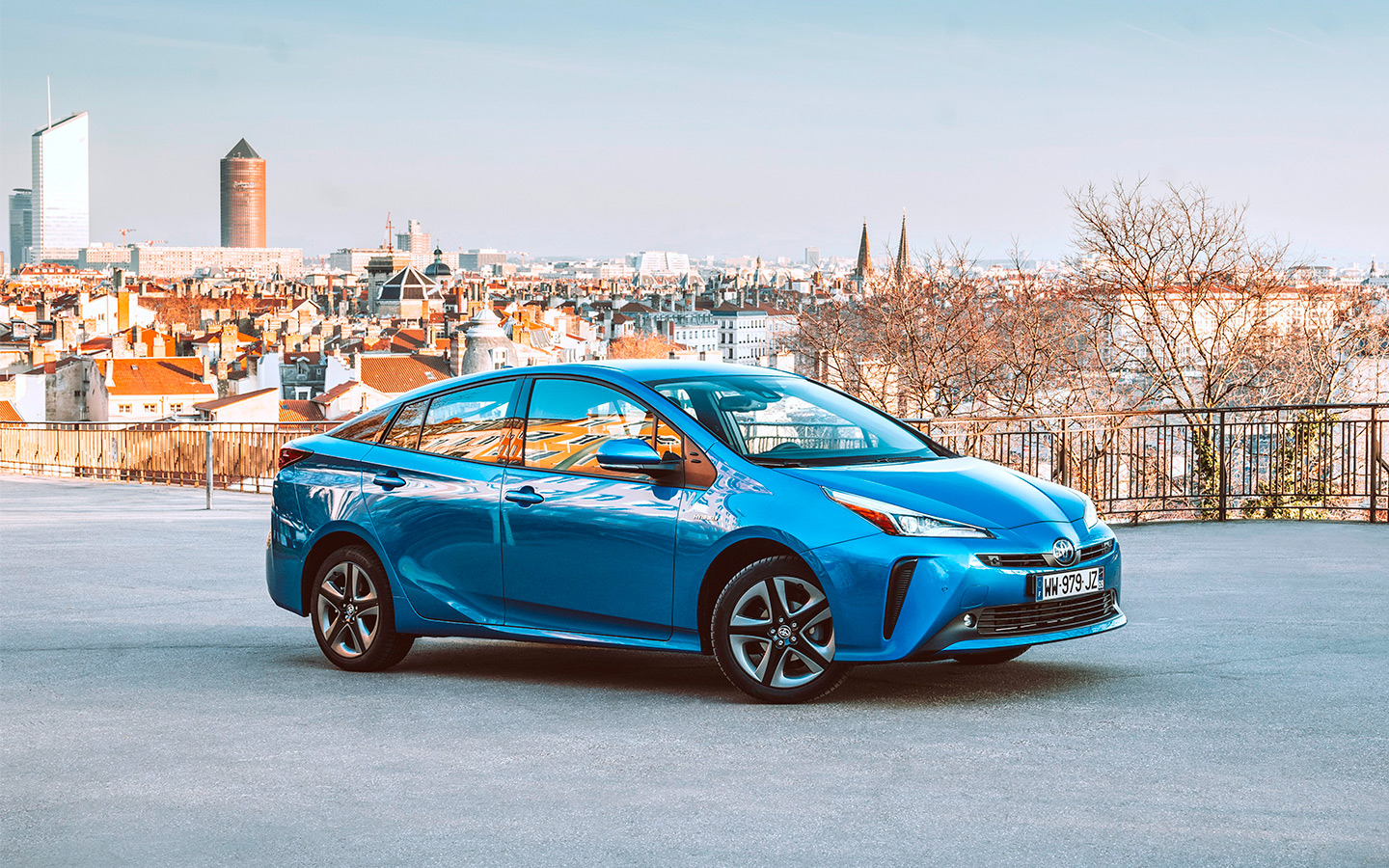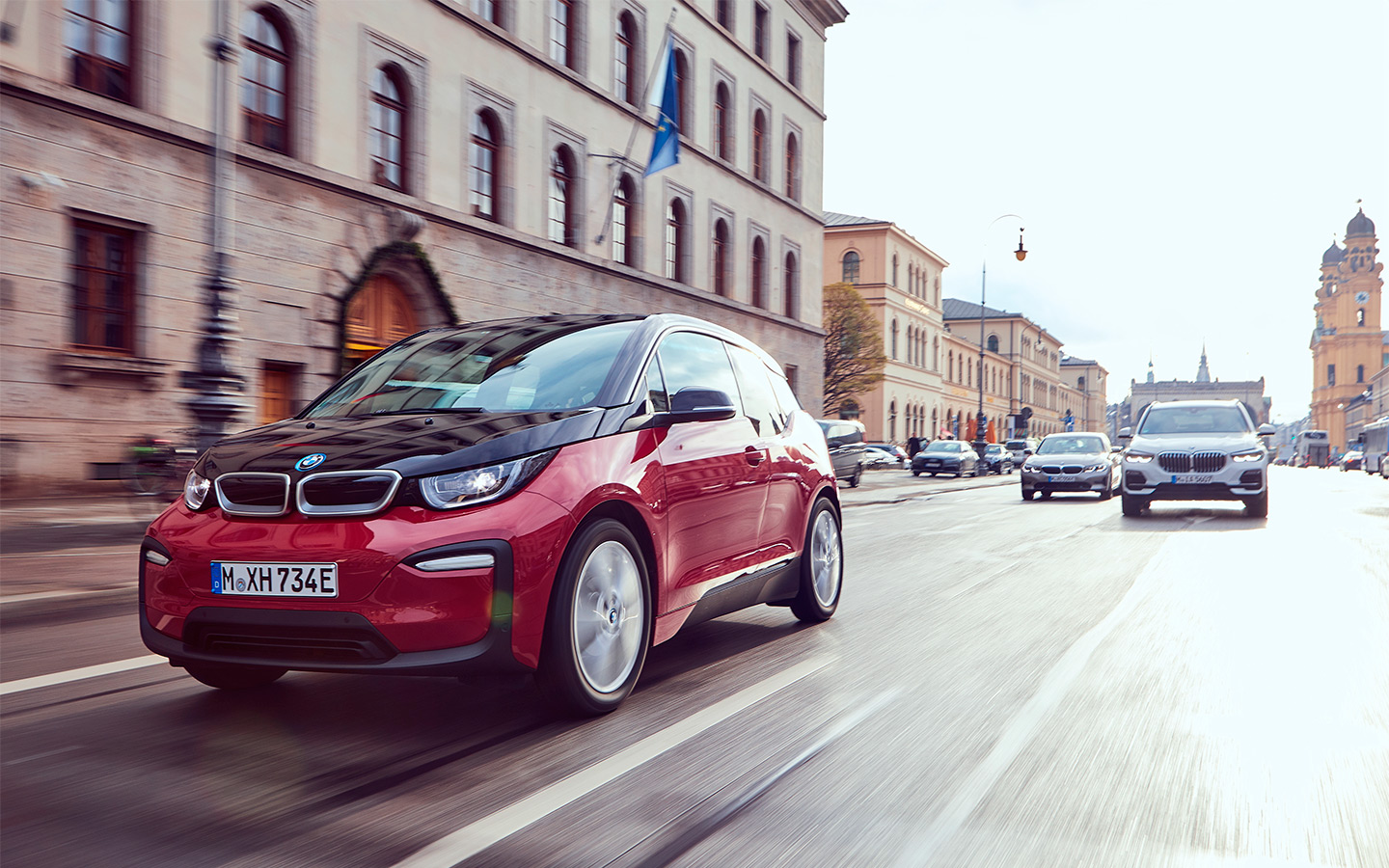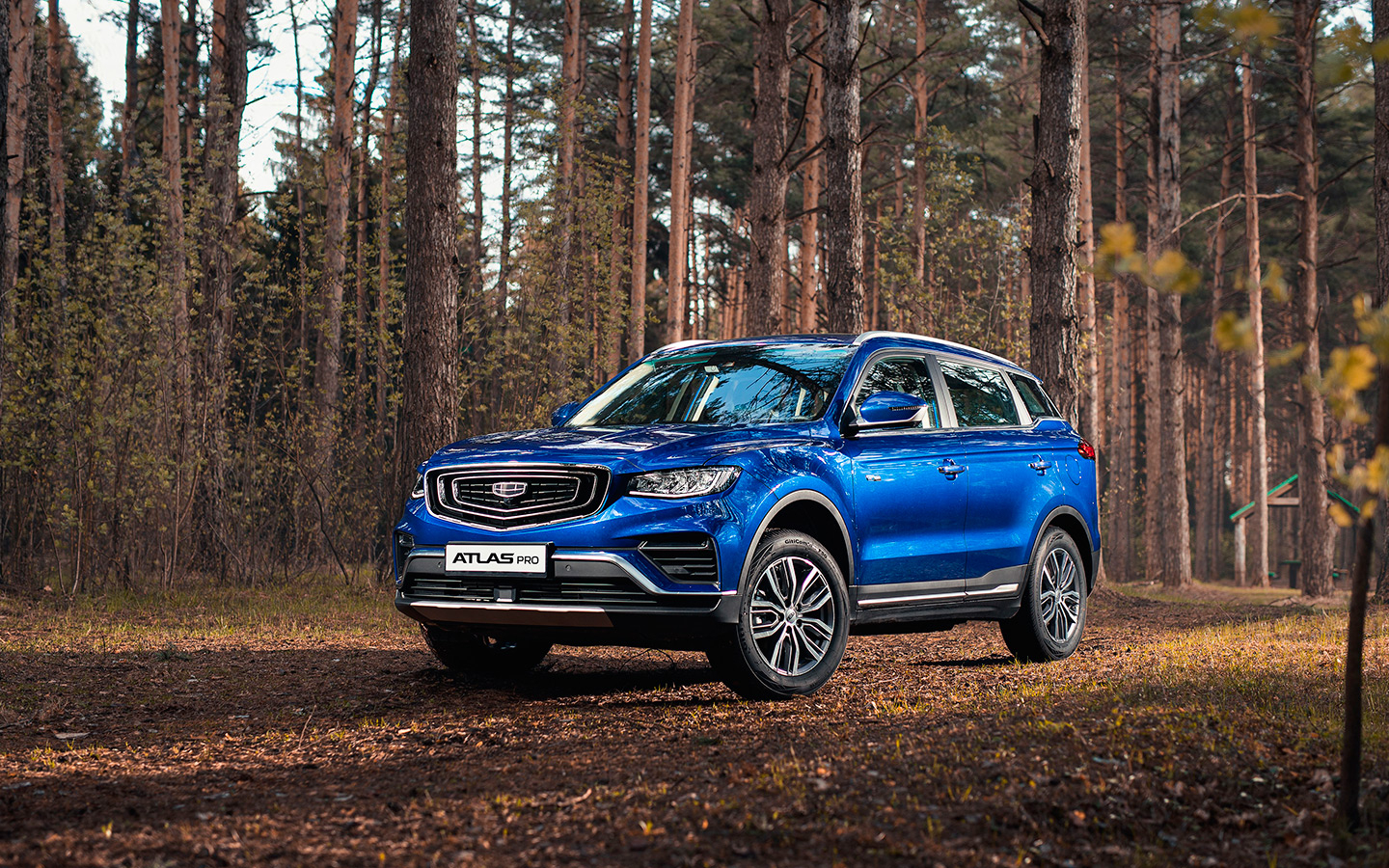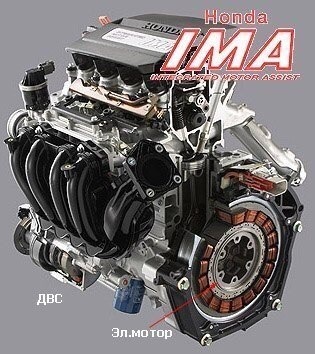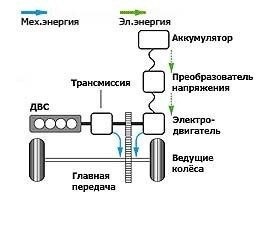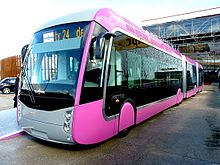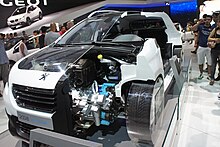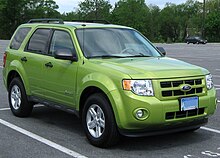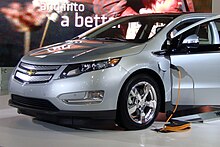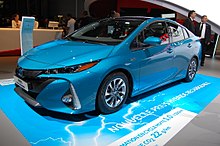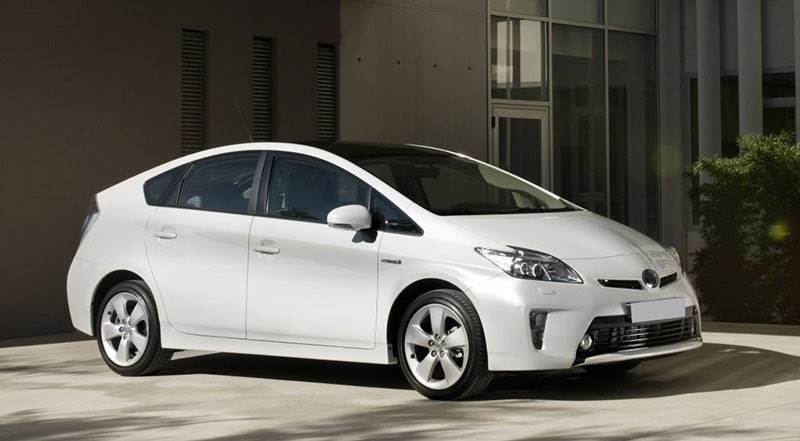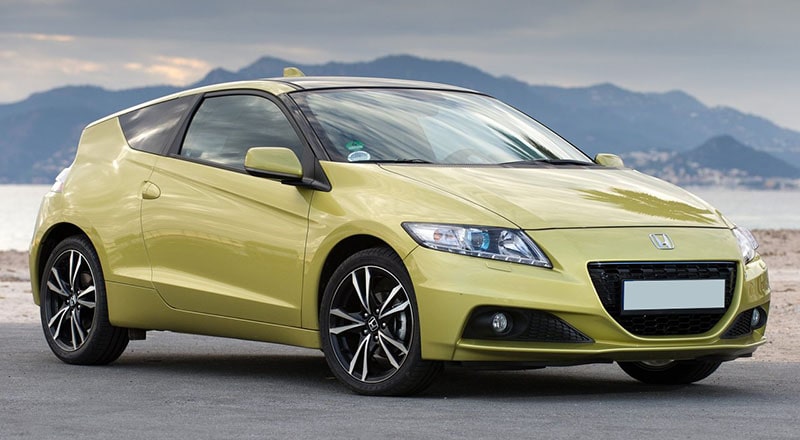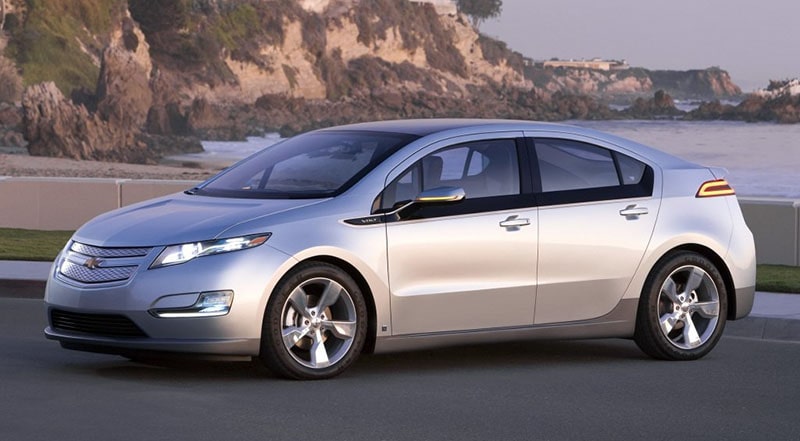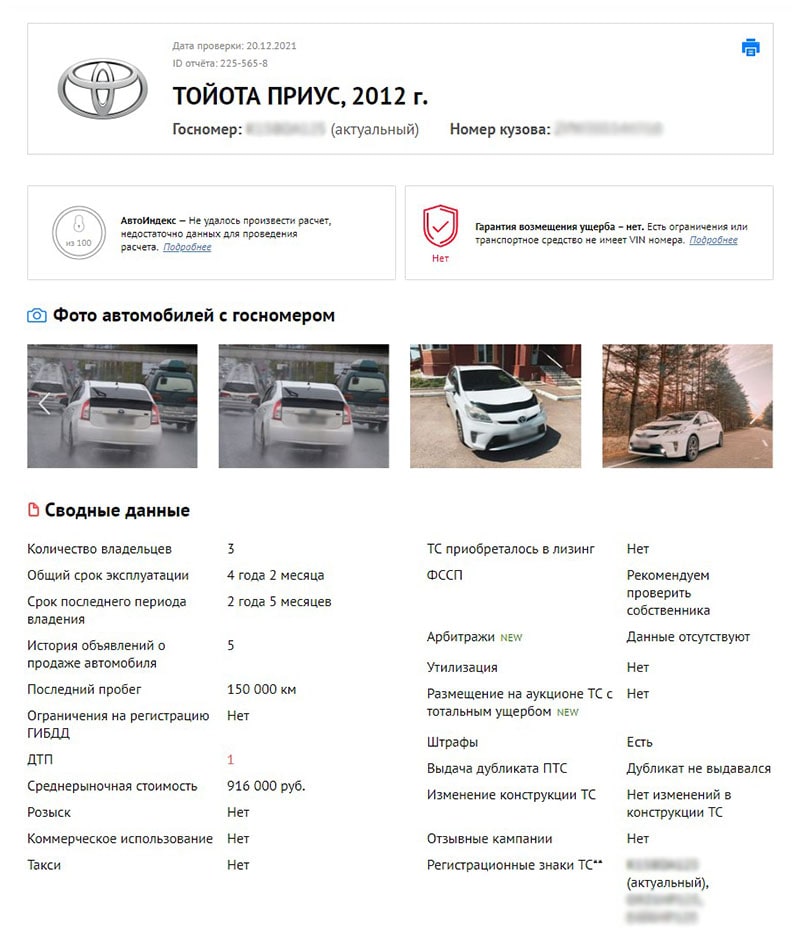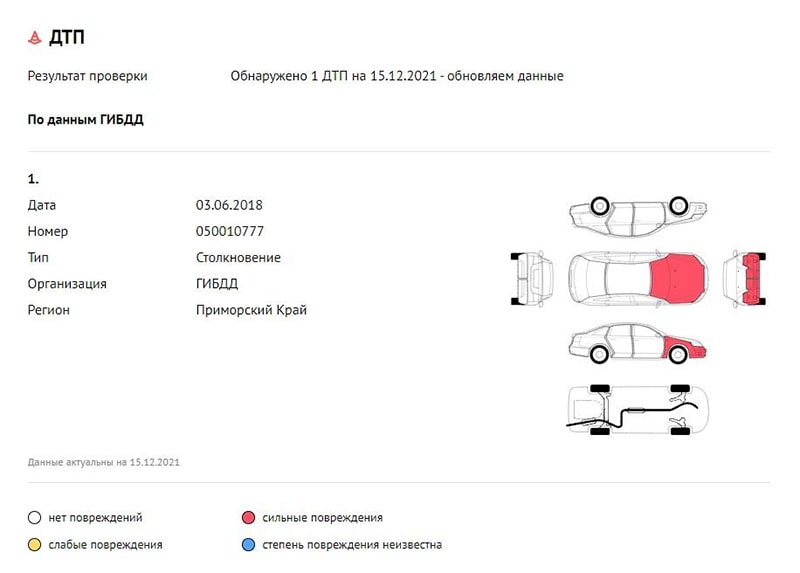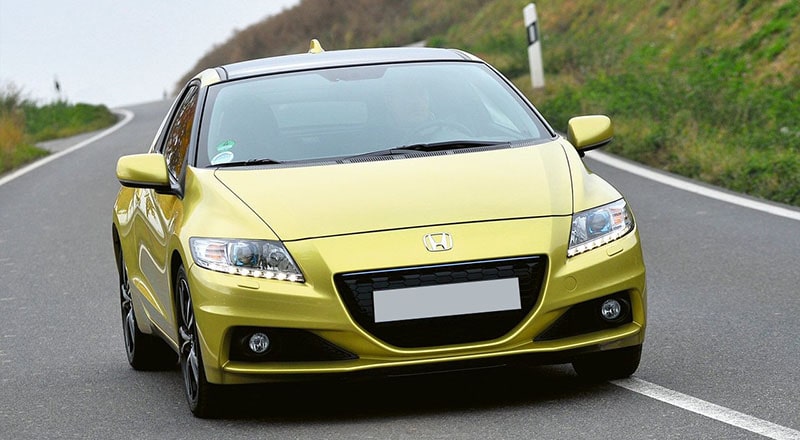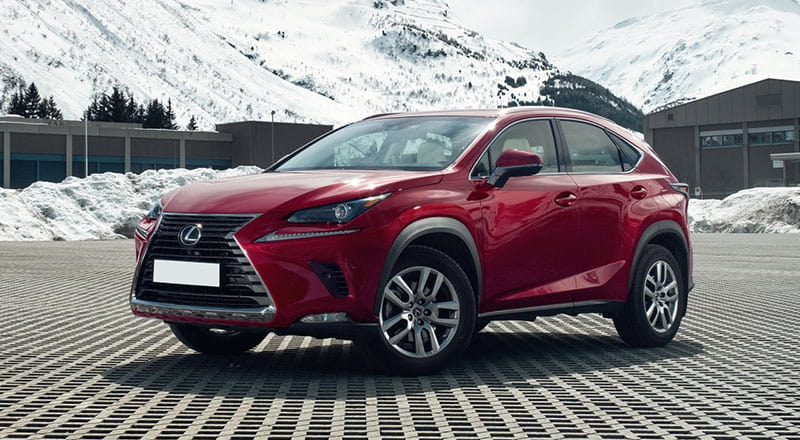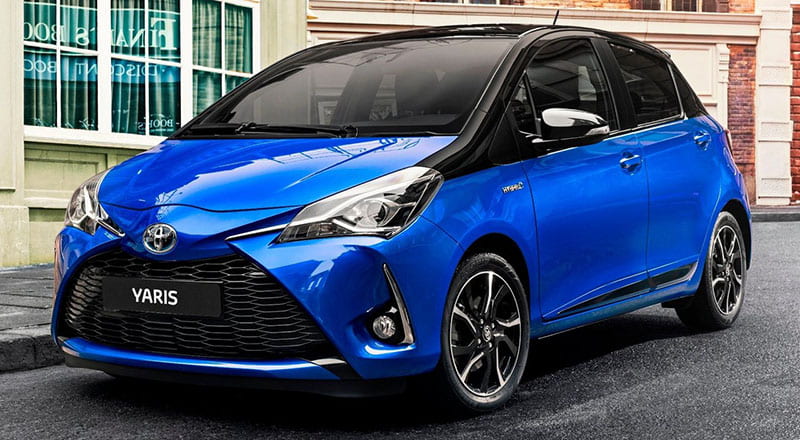Все, что нужно знать о гибридных машинах: типы, нюансы, характеристики
От экономии топлива и снижения вредных выбросов до рекордов скорости: как и зачем автопроизводители совмещают электричество и двигатели внутреннего сгорания
Если максимально кратко, то гибрид — это автомобиль, в котором одновременно используются двигатель внутреннего сгорания и электромотор.
Во многом такое решение можно рассматривать как переходный этап между двумя мирами — машинами, которые сжигают топливо, и стопроцентными электрокарами.
Трудно сказать, когда состоится окончательный переход из одной эры в другую (и состоится ли он вообще), но прямо сейчас производители заявляют, что через 5-10 лет все выпускаемые модели будут в той или иной степени электрифицированы. Это не значит, что ДВС исчезнет как класс, но с высокой долей вероятности можно говорить, что гибриды станут повсеместной нормой. Правда, решать они будут очень разные задачи — в зависимости от конструкции и общей философии.
Типы гибридных автомобилей
Первое и главное, зачем делаются такие машины, — экономия топлива и необходимость вписываться во все более жесткие экологические нормы. Помимо прочего, оценивается средний уровень вредных выбросов по всей модельной линейке каждого производителя, поэтому компании идут на некоторые ухищрения.
«Мягкие» гибриды (mild hybrid)
Самая простая и доступная технология, позволяющая не сильно перекраивать конструкцию автомобиля и при этом демонстрировать нужные показатели по выбросам. В большинстве случаев все сводится к установке мощного стартер-генератора — электромотора, который может как запасать энергию, так и расходовать ее.
Например, в пробках это позволяет расширить функционал системы старт-стоп: двигатель глушится еще до полной остановки автомобиля (в это время как раз накапливается заряд), а при трогании стартер-генератор запускает его и помогает разгоняться в первые несколько секунд. Еще не полноценная езда на электротяге, но уже небольшие ее отголоски.
Помимо некоторой экономии топлива, такая система позволяет сгладить переходные процессы — ведь традиционная схема старт-стоп зачастую работает с рывками, например, когда мотор приходится запускать через секунду после того, как он был заглушен. Кроме того, «мягкому» гибриду не требуется большая батарея, которая увеличивала бы массу и отбирала пространство у пассажиров или багажа. Наконец, большинство подобных автомобилей вместо стандартной 12-вольтовой бортовой сети использует 48-вольтовую, от которой, помимо стартер-генератора, питаются современные технические решения вроде электрических турбонагнетателей и активных стабилизаторов поперечной устойчивости — особенно любят такие решения в немецком премиуме.
В пробках двигатель глушится еще до полной остановки автомобиля (в это время как раз накапливается заряд), а при трогании стартер-генератор запускает его и помогает разгоняться в первые несколько секунд.
(Фото: Марина Лысцева / ТАСС)
При этом традиционная 12-вольтовая сеть в «мягких» гибридах (как, впрочем, и полноценных электромобилях вплоть до Tesla) сохранена: гораздо проще питать фары, мультимедийку, дворники и прочие вспомогательные устройства от традиционного аккумулятора, чем заново изобретать все процессы.
Параллельные гибриды (parallel hybrid)
Именно такие машины можно называть обычными, самыми распространенными гибридами. Емкость батарей здесь уже выше, а электромотор обычно располагается между ДВС и трансмиссией, причем элементы этой цепочки могут работать и сообща, и отдельно друг от друга.
Это позволяет автомобилю перемещаться как на чистой электротяге — когда ДВС заглушен и отсоединен от колес — так и в настоящем гибридном режиме, когда на разгон работают и топливо, и электричество. Кроме того, аккумуляторы можно заряжать на торможениях за счет рекуперации, а также от обычного двигателя, который в этом случае выполняет роль генератора.
Получается своеобразная игра: во дворах и в пробках параллельный гибрид вполне может ездить, не загрязняя атмосферу, а если вам потребуется больше динамики — на помощь придут оба типа энергии и позволят разгоняться активнее, чем на одном только ископаемом топливе. И пусть запас хода на чистой электротяге чаще всего составляет всего несколько километров, при городских режимах эксплуатации экономия топлива оказывается уже ощутимой.
Последовательные гибриды (series hybrid)
В этой схеме вообще не предусмотрена механическая связь двигателя внутреннего сгорания и колес — он только производит энергию для электромоторов. Теоретические плюсы понятны: водитель получает «электрическое» удобство управления тягой без пауз и задержек, ДВС работает в оптимальном режиме и не крутится в отсечку, а машина превращается в милое и почти экологичное привидение с моторчиком.
BMW i3 отметилась опцией под названием range extender, то есть увеличитель запаса хода — ДВС в большинстве случаев бездействует, но готов прийти на помощь, если у вас закончилось электричество.
(Фото: BMW)
Но в реальности этот метод приводит к двойным потерям энергии: сначала на преобразование топлива в электричество, а потом на передачу его к колесам. Поэтому в чистом виде такая схема не используется, зато отдельные модели вроде BMW i3 или Chevrolet Volt отметились опциями под названием range extender, то есть увеличитель запаса хода — ДВС в большинстве случаев бездействует, но готов прийти на помощь, если у вас закончилось электричество. Считайте, просто генератор, который всегда с собой.
Последовательно-параллельные гибриды (parallel-series-hybrid)
Особая категория, представленная, по сути, только запатентованными изобретениями компании Toyota и отдельными силовыми установками, сделанными по лицензии. Здесь ДВС и электричество работают как единое целое, постоянно и бесшовно распределяя энергию туда, где она нужна. Самое массовое применение технология нашла на Toyota Prius, где без особых изменений используется уже почти 15 лет.
Называется этот уникальный привод Hybrid Synergy Drive, а примечателен он в первую очередь тем, что лишен обычной трансмиссии — в то время как в большинстве гибридов используются вариаторы, «роботы» или классические «автоматы». Здесь же два электромотора объединены с ДВС через хитрую планетарную передачу, которая вообще стирает границу между двумя мирами для конечного пользователя. Самый яркий пример — бензиновый двигатель здесь может одновременно работать на разгон и заряжать батареи, если вы не требуете от машины максимальной динамики.
Подключаемые гибриды (plug-in hybrid, PHEV)
Главный принцип здесь один: наличие отдельного разъема для зарядки аккумуляторов. При этом сам гибрид может быть как последовательным (тот же BMW i3 или Fisker Karma), так и параллельным (Porsche Cayenne e-Hybrid или Volvo XC60 Recharge). И если с первым случаем все понятно (по сути это электромобили с бензиновыми генераторами), то параллельные подключаемые гибриды интереснее. Идея заключается в том, что емкость батарей у таких автомобилей уже действительно солидная — например, у современного «Кайена» это 18 кВтч, то есть примерно треть от того, что можно найти в среднем электромобиле. Да и электромотор вполне самостоятелен: на многих подключаемых гибридах его мощность превышает 100 лошадиных сил.
Иными словами, при определенных сценариях вы можете ездить на такой машине, как на настоящем электрокаре: запас хода составляет несколько десятков километров, разгоняться можно до сотни с лишним километров в час — но делать надо все плавно. Прикатили по пробкам в центр на работу, вечером вернулись домой, подзарядились от розетки — и никаких выбросов. При этом в вашем распоряжении остается и настоящий бензиновый двигатель — со всей своей мощностью, универсальностью и возможностью заправляться когда угодно и сколько угодно. Нажимаете акселератор посильнее, и он включается в работу.
У современного «Кайена» емкость батарей — это 18 кВтч, то есть примерно треть от того, что можно найти в среднем электромобиле.
(Фото: Porsche)
Никто не отменял и дополнительной помощи от электромотора: в спортивном режиме бензоэлектрическая силовая установка даст динамику, на которую традиционный ДВС в одиночку будет не способен. Но надо понимать, что без питания от розетки подключаемые гибриды мало чем отличаются от обычных параллельных: да, запас электричества можно принудительно пополнять от бензинового мотора, но эффективности, экологичности и смысла в этом откровенно мало.
Экзотические разновидности
Не во всех случаях гибридная тяга применяется исключительно ради экономии топлива. Например, французы из Peugeot и Citroen при помощи электричества компенсируют отсутствие полноценных полноприводных машин: задние колеса вращаются при помощи электромотора. Для тяжелого бездорожья такая схема подходит слабо, но задачу всепогодного вождения решает довольно успешно.
А производители спорткаров уже давно используют гибридные технологии для того, чтобы их машины ехали быстрее — ведь максимум тяги электромотора доступен всегда и везде, и это здорово помогает на разгонах, когда бензиновый двигатель еще не вышел на пиковую отдачу. Среди ранних образцов подобных машин можно вспомнить Porsche 918 Spyder, а среди современных Koenigsegg Regera или Aston Martin Valkyrie— одни из самых быстрых гиперкаров планеты.
Гибридные автомобили в России
В наших широтах официальные продажи гибридов невелики, причем часть ранее представленных вариантов выкосило кризисом — например, Nissan Murano, Mitsubishi Outlander и даже Toyota Prius. В строю пока остаются кроссоверы Lexus NX и RX, Porsche Cayenne и Panamera, несколько моделей Mercedes-Benz, «подключаемый» Volvo XC90 и россыпь Audi — но там речь идет о «мягком» гибриде.
Впрочем, есть и пополнения: внезапно на российский рынок вышел «мягкий» Geely Atlas Pro, а плюс к тому недавно началось серийное производство отечественного седана Aurus Senat, который по конструкции является самым настоящим параллельным гибридом.
Среди гибридов, продающихся в России есть и пополнения: внезапно на рынок вышел «мягкий» Geely Atlas Pro.
(Фото: Geely)
При этом на вторичном рынке бензоэлектрические машины остаются очень популярными: их охотно везут из-за границы, ведь чаще всего рабочий объем ДВС, по которому рассчитывается таможенная пошлина, невелик — а значит, это хороший способ сэкономить деньги. А последовательные гибриды вроде BMW i3 или Nissan Note наше законодательство вообще считает электрокарами и дополнительной мзды, соответственно, не берет.
Особенности эксплуатации гибридов
В целом, гибридный автомобиль доставляет не больше хлопот, чем традиционный — а в некоторых случаях оказывается даже выгоднее. Например, в моделях, где активно используется рекуперация энергии при замедлении, приходится реже менять тормоза — ведь заметную часть работы берет на себя электромотор. В то же время, владельцам подключаемых гибридов стоит подумать о розетках, где можно будет регулярно пополнять запас электричества, иначе преимущества таких машин сведутся к минимуму.
В остальном электрическая начинка не требует особенного внимания, хотя, безусловно, нельзя обойти вниманием вопрос ресурса аккумуляторов. В среднем они должны служить около 150 тысяч километров — но Toyota, к примеру, дает аж десятилетнюю гарантию. Что случится после выработки ресурса? То же самое, что и со старым мобильником: батарея будет все хуже держать заряд, а гибридный автомобиль станет все больше походить на обычный. При этом замена аккумулятора — дело дорогостоящее, поэтому в покупке очень старого гибрида с большим пробегом особого смысла нет. Впрочем, то же самое во многом можно сказать и про любую традиционную машину.
Электромобили пока стоят дорого и требуют частой зарядки. Если вам нужен экономичный транспорт на каждый день, лучше присмотреться к гибриду. Рассказываем, как работает гибридный автомобиль, в чем его преимущества, и что нужно знать перед покупкой.
Принцип действия гибридного автомобиля
Слово «гибридный» означает «смешанный». Гибридные автомобили используют два источника энергии — горючие нефтепродукты и электричество. В таких машинах больше одного мотора. Силовые агрегаты работают вместе, передавая мощность на колеса через сложную трансмиссию.
Обычно электромотор помогает двигателю внутреннего сгорания в сложных ситуациях: при подъеме, при старте со светофора, при обгоне. Обороты основного мотора снижаются, замедляется износ, сокращается расход топлива, а динамика остается такой же или улучшается.
Принцип работы некоторых гибридов позволяет авто стартовать на электротяге. Лучшие модели проезжают до 50–100 км без запуска двигателя внутреннего сгорания — в городе они едут бесшумно, с нулевым выхлопом.
Есть и гибридные автомобили, в которых одна ось приводится бензиновым двигателем, а вторая — электрическим. Это позволяет повысить проходимость и улучшить управляемость, не усложняя схему автомобиля и почти не увеличивая расходы на его обслуживание.
Преимущества и недостатки гибридов
Главный плюс гибридного автомобиля — меньший расход топлива. Toyota Prius 2021 года потребляет 4,3 литров бензина на 100 км в смешанном цикле. Сопоставимая по мощности Skoda Octavia 1,6 MPI расходует 7,5 литров топлива в тех же условиях. При среднем годовом пробеге 16 000 км и стоимости бензина 50 рублей за литр машины потратят:
- Skoda Octavia — 7,5 * (16 000 / 100) * 50 = 7,5 * 160 * 50 = 60 000 рублей;
- Toyota Prius — 4,3 * 160 * 50 = 34 400 рублей.

Если учесть, что Toyota Prius может заряжаться от сети и проезжать около 30 км на электротяге, мы получим еще более впечатляющую цифру. Разделив среднегодовой пробег на число рабочих дней в году, получим 60 км в день. Половину из них гибрид проезжает на электричестве, затрачивая 5 кВт*ч энергии. Стоимость одного киловатта в Москве — 5,66 рублей. Тогда затраты равны:
- бензин — 4,3 * (8 000 / 100) * 50 = 17 200 рублей;
- электричество — (8000 / 30) * 5 * 5,66 = 7 550 рублей;
- итого — 17 200 + 7 550 = 24 750 рублей.
Годовая экономия — 35 250 рублей.
Сниженный расход топлива гибридных автомобилей — не единственный плюс. Гибриды дольше обходятся без заправки. Toyota Prius может добраться от Москвы до Санкт-Петербурга без посещения АЗС. Если гибридная машина может двигаться на электротяге, она шумит намного меньше бензиновой — комфортнее как для пассажиров, так и для окружающих. Кроме того, электромотор развивает максимальный крутящий момент на малых оборотах — гибрид быстрее стартует с места.

Часто приходится слышать о том, что гибридные автомобили требуют больше затрат на ремонт. Это популярный миф, расходы на обслуживание даже ниже. Бензиновый двигатель работает в максимально щадящих условиях и изнашивается медленнее. Но проблема с ремонтом существует: в России пока мало автомехаников, которые специализируются на гибридном приводе и электромоторах. Приготовьтесь к тому, что на специализированном СТО будет очередь.
Классификация гибридных автомобилей по устройству
Микрогибриды
Вместо обычного стартера установлен мощный мотор-генератор. При плавном замедлении он вырабатывает электричество, заряжая батарею повышенной емкости. Двигатель внутреннего сгорания тратит меньше энергии на вращение обычного генератора или не тратит ее вовсе. Такую технологию устройства гибридов используют Mazda, Hyundai, BMW, Audi и другие бренды. Она сокращает расход топлива на 5–15 % в зависимости от манеры вождения.
Мягкие (умеренные) гибриды
Двигателю внутреннего сгорания помогает электромотор малой мощности до 30 лошадиных сил. Он включается в особо тяжелых условиях, чтобы снизить расход топлива и замедлить износ. Машина не может двигаться на электротяге. В лучшем случае она стартует бесшумно, а на скорости выше 5 км/ч запускается бензиновый двигатель. Источником питания служат компактные батареи или конденсаторы. Последние дешевле, надежнее и менее чувствительны к холоду. Технологию умеренного гибрида используют General Motors, Honda, BMW и даже Ferrari. Экономия топлива достигает 15–25 %.
Параллельный гибрид
Автомобиль может двигаться на чистой электротяге до 30–150 км без запуска двигателя внутреннего сгорания. Чаще всего дополнительный мотор установлен в силовом агрегате между основным двигателем и коробкой передач. Тогда его мощность невелика — до 50 лошадиных сил. Он работает самостоятельно, когда вы едете с постоянной скоростью 30–60 км/ч, без динамичных рывков. Такую конструкцию используют Volkswagen, Porsche, Audi и Mercedes-Benz.
Если электромотор установлен отдельно, его мощность не ограничивается — у некоторых моделей она превышает 200 лошадиных сил. Соответственно, вы получаете лучшую динамику на чистой электротяге. Такую технологию предпочитают Toyota, BMW и Lexus.
Иногда двигатель внутреннего сгорания и электромотор установлены на разных осях. Так удается получить полный привод с относительно простой механической схемой. Проходимость автомобиля повышается, расход топлива снижается, управляемость улучшается. По такой схеме работают гибридные авто Peugeot, Citroën, Nissan и FIAT.
Последовательный гибрид
Автомобиль всегда движется на электротяге. Запас хода — от 150–200 километров. Когда батарея разряжается, запускается двигатель внутреннего сгорания. Здесь он служит генератором, который не связан с колесами напрямую. Мотор работает в спокойном режиме при постоянных оборотах, поэтому изнашивается он намного медленнее, чем в обычных автомобилях. Расход топлива — от 1,5 до 3,5 литров на 100 км. Серийных примеров пока немного, можно вспомнить Chevrolet Volt и Opel Ampera.
Параллельно–последовательный гибрид
Такой гибридный автомобиль сочетает особенности двух конструкций. Когда он едет по ровной дороге с постоянным темпом, двигатель внутреннего сгорания вращает мощный генератор и заряжает батарею. Когда нагрузка повышается, включается электромотор, который ускоряет разгон и помогает преодолевать неровности. Такую схему довела до совершенства Toyota. Ее также можно встретить в Volvo и BMW.
Перспективы гибридизации
Гибридные автомобили изначально создавались для американского и японского рынков. Там были «обкатаны» технологии и испробованы разные варианты компоновки. Популярность гибридов растет — они появляются в других странах, включая Россию. Цена снижается, что делает их более доступными для широкой публики. В 2021 году гибридные машины стоит покупать ради их надежности, динамики и впечатляющего запаса хода. В ближайшие годы список преимуществ пополнится экономичностью. Если разница в цене будет окупаться за 4–5 лет, владеть гибридом будет намного выгоднее. Требования к двигателям внутреннего сгорания постоянно ужесточаются. Поэтому к 2030–2035 годам гибридные машины могут стать единственной альтернативой электрокарам.
23.06.2021

— Совершенствование двигателей внутреннего сгорания (ДВС) едва-едва поспевает за предъявляемыми к ним требованиями. С одной стороны, потребители с мечтами об одновременно мощном и экономичном моторе, с другой — экологи, ужесточающие нормы токсичности. А в завершение — геологи, все настойчивее напоминающие об истощении запасов «черного золота». Одним из вариантов решения этой проблемы являются гибридные силовые установки, состоящие из обычного ДВС и электродвигателя. В отличие от электромобилей и автомобилей на топливных элементах, которые все еще остаются «автомобилями будущего», гибриды уже с 1997 года выпускаются серийно.
— Давайте сравним автомобиль с обычным ДВС и электромобиль. Обыкновенный автомобиль способен проехать без дозаправки четыре-пять сотен километров и при этом отравить атмосферу некоторым объёмом вредных веществ. Заправочных станций предостаточно в любом регионе, и пополнить запасы топлива можно за считанные минуты. Электромобиль может проехать на одном заряде батарей порядка 80-160 км. Он экологически чист, бесшумен и практически безупречен до того момента, пока не наступает очередь подзарядки аккумуляторов. У существующих в наше время «электрических» машин этот процесс длится несколько часов.
Гибридные автомобили берут все лучшее от обоих моторов: ДВС и электрического. Достоинство первого – в удобном энергоносителе, жидком топливе, а второго – в выдающихся моментных характеристиках. В отличие от ДВС, электромотор не нужно заводить и «раскручивать». Он может «стоять и ждать» не потребляя энергии. Но как только дали ток – сразу получили максимальную тягу на колесах. Электродвигатель эффективнее двигателя внутреннего сгорания в режиме частых стартов и стопов (т.е., при езде в городском цикле). Двигатель внутреннего сгорания, наоборот, более эффективен на постоянных, оптимальных для данного двигателя оборотах.
В гибриде оба двигателя работают друг на друга. ДВС крутит генератор и питает энергией электромотор. Тот, в свою очередь, позволяет ДВС работать без резких разгонных нагрузок, в наиболее благоприятных режимах. Практически все современные гибриды имеют систему рекуперации или, по-русски, «возврата энергии». Суть ее в том, что при торможении или при движении машины накатом, электродвигатели начинают крутиться от колес и работать как генераторы, заряжая батарею. Отсюда – меньший износ, экологичность и экономичность (особенно в городском цикле.)
Итак, перед нами технологичный прогрессивный автомобиль, в котором нивелируются недостатки и объединяются достоинства двух моторов. Но., рано хлопать в ладоши, и послушаем, что говорят скептики.
— Гибридные автомобили сложнее и дороже традиционных автомобилей с двигателями внутреннего сгорания. Аккумуляторные батареи имеют небольшой диапазон рабочих температур, не любят морозов, подвержены саморазряду, срок службы их ограничен несколькими годами. А «экономность» гибрида прямо связана с состоянием АКБ. Кроме того, существует проблема утилизации отработанных батарей. Гибриды дороже в ремонте, да и за сам ремонт возьмется далеко не каждый. Кроме того, высокую экологичность и экономичность гибридов многие тоже ставят под сомнение. Так, ряд тестов, проведенных авторитетными автомобильными изданиями, показал, что гибриды дают заметную экономию топлива только в городе, при движении же в смешанном цикле незначительно, а за городом существенно проигрывают современным дизелям. Почетное звание «Самый экологичный автомобиль года» в 2007 и 2008 годах присуждалось также автомобилям с дизельными моторами.
Рассмотрим подробнее, какими бывают и как устроены гибриды.
По степени гибридизации их делят на «умеренные», «полные» и plug-in. «Полный» в состоянии двигаться лишь на электричестве, не потребляя топлива. «Умеренный» всегда задействует ДВС, а электромотор подключается, если требуется дополнительная мощность. Гибрид с подзарядкой (plug-in hybrid) — такой гибрид можно включать в розетку для подзарядки. В результате обладатель подобного гибрида получает все преимущества электрического автомобиля, без самого большого недостатка: ограниченного пробега на одном заряде. Когда электрический заряд заканчивается, подключается ДВС и автомобиль превращается в обычный гибрид.
По принципу взаимодействия электрической и топливной составляющих авто, гибридные приводы принято разделять на три вида: последовательный, параллельный и последовательно-параллельный.
• ПОСЛЕДОВАТЕЛЬНАЯ СХЕМА:
— Это — самая простая гибридная конфигурация. ДВС используется только для привода генератора, а вырабатываемая последним электроэнергия заряжает аккумуляторную батарею и питает электродвигатель, который и вращает ведущие колеса. Это избавляет от необходимости в коробке передач и сцеплении. Для подзарядки аккумулятора также используется рекуперативное торможение. Свое название схема получила потому, что поток мощности поступает на ведущие колеса, проходя ряд последовательных преобразований. От механической энергии, вырабатываемой ДВС в электрическую, вырабатываемую генератором, и опять в механическую. При этом часть энергии неизбежно теряется. Последовательный гибрид позволяет использовать ДВС малой мощности, причем он постоянно работает в диапазоне максимального КПД, или же его можно совсем отключить. При отключении ДВС электродвигатель и батарея в состоянии обеспечить необходимую мощность для движения. Поэтому они, в отличие от ДВС, должны быть более мощными, а, значит, они имеют и большую стоимость. Наиболее эффективна последовательная схема при движении в режиме частых остановок, торможений и ускорений, движении на низкой скорости, т.е. в городе. Поэтому используют ее в городских автобусах и других видах городского транспорта. По такому принципу работают также большие карьерные самосвалы, где необходимо передать большой крутящий момент на колеса, и не требуются высокие скорости движения.
• ПАРАЛЛЕЛЬНАЯ СХЕМА:
— Здесь ведущие колеса приводятся в движение и ДВС, и электродвигателем (который должен быть обратимым, т.е. может работать в качестве генератора). Для их согласованной параллельной работы используется компьютерное управление. При этом сохраняется необходимость в обычной трансмиссии, и двигателю приходится работать в неэффективных переходных режимах. Момент, поступающий от двух источников, распределяется в зависимости от условий движения: в переходных режимах (старт, ускорение) в помощь ДВС подключается электродвигатель, а в устоявшихся режимах и при торможении он работает как генератор, заряжая аккумулятор. Таким образом, в параллельных гибридах большую часть времени работает ДВС, а электродвигатель используется для помощи ему. Поэтому параллельные гибриды могут использовать меньшую аккумуляторную батарею, по сравнению с последовательными. Так как ДВС непосредственно связан с колесами, то и потери мощности значительно меньше, чем в последовательном гибриде. Подобная конструкция достаточно проста, но ее недостатком является то, что обратимая машина параллельного гибрида не может одновременно приводить в движение колеса и заряжать батарею. Параллельные гибриды эффективны на шоссе, но малоэффективны в городе. Несмотря на простоту реализации этой схемы, она не позволяет значительно улучшить как экологические параметры, так и эффективность использования ДВС.
— Приверженцем такой схемы гибридов является компания «Хонда». Их гибридная система получила название Integrated Motor Assist (Интегрированный помощник двигателя). Она предусматривает, прежде всего, создание бензинового двигателя с увеличенным к.п.д. И только тогда, когда двигателю становится трудно, на помощь ему должен приходить электрический мотор. В этом случае система не требует сложного и дорогостоящего силового блока управления, и, следовательно, себестоимость такого автомобиля оказывается ниже. Система IMA состоит из бензинового двигателя (который предоставляет основной ресурс мощности), электромотора, который предоставляет дополнительную мощность и дополнительной батареи для электромотора. Когда автомобиль с обычным бензиновым двигателем замедляется, его кинетическая энергия гасится сопротивлением мотора (торможение двигателем) или рассеивается в виде тепла при нагреве тормозных дисков и барабанов. Автомобиль с системой IMA начинает тормозить электромотором. Таким образом, электромотор работает как генератор, вырабатывая электричество. Сохранённая при торможении энергия запасается в батарее. И когда автомобиль вновь начнёт ускоряться, батарея отдаст всю накопленную энергию на раскрутку электромотора, который снова перейдёт на свои тяговые функции. А расход бензина уменьшится ровно настолько, сколько энергии было запасено при предыдущих торможениях. В общем, в компании Honda считают, что гибридная система должна быть максимально простой, электрический мотор выполняет лишь одну функцию — помогает двигателю внутреннего сгорания сэкономить как можно больше горючего. Honda выпускает две гибридные модели:Insight и Civic.
• ПОСЛЕДОВАТЕЛЬНО-ПАРАЛЛЕЛЬНАЯ СХЕМА:
— Компания «Тойота» при создании гибридов пошла своим путем. Разработанная японскими инженерами система Hybrid Synergy Drive (HSD) объединяет в себе особенности двух предыдущих типов. В схему параллельного гибрида добавляется отдельный генератор и делитель мощности (планетарный механизм). В результате гибрид приобретает черты последовательного гибрида: автомобиль трогается и движется на малых скоростях только на электротяге. На высоких скоростях и при движении с постоянной скоростью подключается ДВС. При высоких нагрузках (ускорение, движение в гору и т.п.) электродвигатель дополнительно подпитывается от аккумулятора- т.е. гибрид работает как параллельный. Благодаря наличию отдельного генератора, заряжающего батарею, электродвигатель используется только для привода колес и при рекуперативном торможении. Планетарный механизм передает часть мощности ДВС на колеса, а остальную часть на генератор, который либо питает электродвигатель, либо заряжает батарею. Компьютерная система постоянно регулирует подачу мощности от обоих источников энергии для оптимальной эксплуатации при любых условиях движения. В этом типе гибрида большую часть времени работает электродвигатель, а ДВС используется только в наиболее эффективных режимах. Поэтому его мощность может быть ниже, чем в параллельном гибриде.
Важной особенностью ДВС также является то, что он работает по циклу Аткинсона, а не по циклу Отто, как обычные двигатели. Если работа двигателя организована по циклу Отто, то на такте впуска поршень, двигаясь вниз, создает в цилиндре разрежение, благодаря которому происходит всасывание в него воздуха и топлива. При этом в режиме малых оборотов, когда дроссельная заслонка почти закрыта, появляются так наз. насосные потери. (Чтобы лучше понять, что это такое, попробуйте, например, втянуть воздух через зажатые ноздри). Кроме того, при этом ухудшается наполнение цилиндров свежим зарядом и соответственно повышается расход топлива и выбросы вредных веществ в атмосферу. Когда поршень достигает нижней мертвой точки (НМТ), впускной клапан закрывается. В ходе такта выпуска, когда открывается выпускной клапан, отработанные газы еще находятся под давлением, и их энергия безвозвратно теряется- это так наз. потери выпуска.
— В двигателе Аткинсона на такте впуска впускной клапан закрывается не вблизи НМТ, а значительно позже. Это дает целый ряд преимуществ. Во-первых, снижаются насосные потери, т. к. часть смеси, когда поршень прошел НМТ и начал движение вверх, выталкивается назад во впускной коллектор (и используется затем в другом цилиндре), что снижает в нем разрежение. Горючая смесь, выталкиваемая из цилиндра, также уносит с собой часть тепла с его стенок. Так как длительность такта сжатия по отношению к такту рабочего хода уменьшается, то двигатель работает по так наз. циклу с увеличенной степенью расширения, при котором энергия отработанных газов используется более длительное время, т. е., с уменьшением потерь выпуска. Данная стать Таким образом, получаем лучшие экологические показатели, экономичность и больший КПД, но меньшую мощность. Но в том-то и суть, что мотор тойотовского гибрида функционирует в малонагруженных режимах, при которых этот недостаток цикла Аткинсона не играет большой роли.
— К недостаткам последовательно- параллельного гибрида следует отнести более высокую стоимость, в виду того, что он нуждается в отдельном генераторе, большем блоке батарей, и более производительной и сложной компьютерной системе управления.
— Система HSD установливается на хэтчбеке Toyota Prius, седане бизнес-класса Camry, вседорожниках Lexus RX400h, Toyota Highlander Hybrid, Harrier Hybrid, спортивном седане Lexus GS 450h и автомобиле люкс-класса — Lexus LS 600h. Ноу-хау компании Тойота куплено компаниями Форд и Ниссан и использовано при создании Ford Escape Hybrid и Nissan Altima Hybrid. Toyota Prius лидирует по продажам среди всех гибридов. Расход бензина в городе составляет 4 л на 100 км пробега. Это первый автомобиль, у которого потребление топлива при движении в городе меньше, чем на шоссе. На Парижском автосалоне 2008 была представлена модель Приус plug-in hybrid.
Из всего сказанного можно сделать вывод, что, наверное, нет смысла считать гибридные автомобили решением всех проблем. Это скорее промежуточный этап на пути к будущей машине с нулевым выбросом вредных веществ. Гибридные технологии дают возможность отработать ее ключевые технические компоненты — емкие компактные аккумуляторы, оптимизированные системы «повторного использования» энергии, технологию быстрой зарядки от внешних источников, новые электродвигатели, облегченные кузова. Только массовое производство этих узлов сможет приблизить то время, когда вместо поездки на заправку достаточно будет подключить железного коня на часок к обычной домашней электросети — а потом ездить целый день без подзарядки. Похоже, что, сев за руль гибридного автомобиля, человеческая цивилизация сможет прибыть в светлое электромобильное будущее самым коротким и самым эффективным путем.
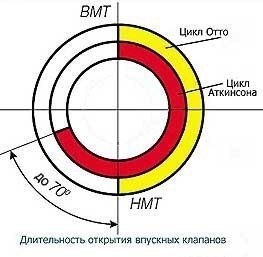
A hybrid vehicle is one that uses two or more distinct types of power, such as submarines that use diesel when surfaced and batteries when submerged. Other means to store energy include pressurized fluid in hydraulic hybrids.
Hybrid powertrains are designed to switch from one power source to another to maximize both fuel efficiency and energy efficiency. In hybrid electric vehicles, for instance, the electric motor is more efficient at producing torque, or turning power, while the combustion engine is better for maintaining high speed. Improved efficiency, lower emissions, and reduced running costs relative to non-hybrid vehicles are three primary benefits of hybridization.
Vehicle types[edit]
Two-wheeled and cycle-type vehicles[edit]
Mopeds, electric bicycles, and even electric kick scooters are a simple form of a hybrid, powered by an internal combustion engine or electric motor and the rider’s muscles. Early prototype motorcycles in the late 19th century used the same principle.
- In a parallel hybrid bicycle human and motor torques are mechanically coupled at the pedal or one of the wheels, e.g. using a hub motor, a roller pressing onto a tire, or a connection to a wheel using a transmission element. Most motorized bicycles, mopeds are of this type.[1]
- In a series hybrid bicycle (SHB) (a kind of chainless bicycle) the user pedals a generator, charging a battery or feeding the motor, which delivers all of the torque required. They are commercially available, being simple in theory and manufacturing.[2]
The first published prototype of an SHB is by Augustus Kinzel (US Patent 3’884’317) in 1975. In 1994 Bernie Macdonalds conceived the Electrilite[3] SHB with power electronics allowing regenerative braking and pedaling while stationary. In 1995 Thomas Muller designed and built a «Fahrrad mit elektromagnetischem Antrieb» for his 1995 diploma thesis. In 1996 Jürg Blatter and Andreas Fuchs of Berne University of Applied Sciences built an SHB and in 1998 modified a Leitra tricycle (European patent EP 1165188). Until 2005 they built several prototype SH tricycles and quadricycles.[4] In 1999 Harald Kutzke described an «active bicycle»: the aim is to approach the ideal bicycle weighing nothing and having no drag by electronic compensation.
- A series hybrid electric-petroleum bicycle (SHEPB) is powered by pedals, batteries, a petrol generator, or plug-in charger—providing flexibility and range enhancements over electric-only bicycles.
A SHEPB prototype made by David Kitson in Australia[5] in 2014 used a lightweight brushless DC electric motor from an aerial drone and small hand-tool sized internal combustion engine, and a 3D printed drive system and lightweight housing, altogether weighing less than 4.5 kg. Active cooling keeps plastic parts from softening. The prototype uses a regular electric bicycle charge port.
Heavy vehicle[edit]
Hybrid power trains use diesel-electric or turbo-electric to power railway locomotives, buses, heavy goods vehicles, mobile hydraulic machinery, and ships. A diesel/turbine engine drives an electric generator or hydraulic pump, which powers electric/hydraulic motors—strictly an electric/hydraulic transmission (not a hybrid), unless it can accept power from outside. With large vehicles, conversion losses decrease and the advantages in distributing power through wires or pipes rather than mechanical elements become more prominent, especially when powering multiple drives—e.g. driven wheels or propellers. Until recently most heavy vehicles had little secondary energy storage, e.g. batteries/hydraulic accumulators—excepting non-nuclear submarines, one of the oldest production hybrids, running on diesel while surfaced and batteries when submerged. Both series and parallel setups were used in World War II-era submarines.
Rail transport[edit]
Europe
The new Autorail à grande capacité (AGC or high-capacity railcar) built by the Canadian company Bombardier for service in France is diesel/electric motors, using 1500 or 25000 V on different rail systems.[7] It was tested in Rotterdam, the Netherlands with Railfeeding, a Genesee & Wyoming company.
China
The First Hybrid Evaluating locomotive was designed by rail research center Matrai in 1999 and built in 2000. It was an EMD G12 locomotive upgraded with batteries, a 200 kW diesel generator, and four AC motors.
Japan
Japan’s first hybrid train with significant energy storage is the KiHa E200, with roof-mounted lithium ion batteries.[8]
India
Indian railway launched one of its kind CNG-Diesel hybrid trains in January 2015. The train has a 1400 hp engine which uses fumigation technology. The first of these trains is set to run on the 81 km long Rewari-Rohtak route.[9] CNG is less-polluting alternative for diesel and petrol and is popular as an alternative fuel in India. Already many transport vehicles such as auto-rickshaws and buses run on CNG fuel.
North America
In the US, General Electric made a locomotive with sodium–nickel chloride (Na-NiCl2) battery storage. They expect ≥10% fuel economy.[10][failed verification]
Variant diesel electric locomotive include the Green Goat (GG) and Green Kid (GK) switching/yard engines built by Canada’s Railpower Technologies, with lead acid (Pba) batteries and 1000 to 2000 hp electric motors, and a new clean-burning ≈160 hp diesel generator. No fuel is wasted for idling: ≈60–85% of the time for these types of locomotives. It is unclear if regenerative braking is used; but in principle, it is easily utilized.
Since these engines typically need extra weight for traction purposes anyway the battery pack’s weight is a negligible penalty.[citation needed] The diesel generator and batteries are normally built on an existing «retired» «yard» locomotive’s frame. The existing motors and running gear are all rebuilt and reused. Fuel savings of 40–60% and up to 80% pollution reductions are claimed over a «typical» older switching/yard engine. The advantages hybrid cars have for frequent starts and stops and idle periods apply to typical switching yard use.[11] «Green Goat» locomotives have been purchased by Canadian Pacific, BNSF, Kansas City Southern Railway and Union Pacific among others.
Cranes[edit]
Railpower Technologies engineers working with TSI Terminal Systems are testing a hybrid diesel-electric power unit with battery storage for use in Rubber Tyred Gantry (RTG) cranes. RTG cranes are typically used for loading and unloading shipping containers onto trains or trucks in ports and container storage yards. The energy used to lift the containers can be partially regained when they are lowered. Diesel fuel and emission reductions of 50–70% are predicted by Railpower engineers.[12] First systems are expected to be operational in 2007.[13]
Road transport, commercial vehicles[edit]
Hybrid systems are regularly in use for trucks, buses and other heavy highway vehicles. Small fleet sizes and installation costs are compensated by fuel savings,[14][needs update] with advances such as higher capacity, lowered battery cost, etc. Toyota, Ford, GM and others are introducing hybrid pickups and SUVs. Kenworth Truck Company recently introduced the Kenworth T270 Class 6 that for city usage seems to be competitive.[15][16] FedEx and others are investing in hybrid delivery vehicles—particularly for city use where hybrid technology may pay off first.[17] As of December 2013 FedEx is trialling two delivery trucks with Wrightspeed electric motors and diesel generators; the retrofit kits are claimed to pay for themselves in a few years. The diesel engines run at a constant RPM for peak efficiency.[18]
In 1978 students at Minneapolis, Minnesota’s Hennepin Vocational Technical Center, converted a Volkswagen Beetle to a petro-hydraulic hybrid with off-the shelf components. A car rated at 32 mpg was returning 75 mpg with the 60 hp engine replaced by a 16 hp engine, and reached 70 mph.[19]
In the 1990s, engineers at EPA’s National Vehicle and Fuel Emissions Laboratory developed a petro-hydraulic powertrain for a typical American sedan car. The test car achieved over 80 mpg on combined EPA city/highway driving cycles. Acceleration was 0-60 mph in 8 seconds, using a 1.9 liter diesel engine. No lightweight materials were used. The EPA estimated that produced in high volumes the hydraulic components would add only $700 to the cost.[20] Under EPA testing, a hydraulic hybrid Ford Expedition returned 32 mpg (7.4 L/100 km) City, and 22 mpg (11 L/100 km) highway.[20][21] UPS currently has two trucks in service using this technology.[22]
Military off-road vehicles[edit]
Since 1985, the US military has been testing serial hybrid Humvees[23][24] and have found them to deliver faster acceleration, a stealth mode with low thermal signature, near silent operation, and greater fuel economy.
Ships[edit]
Ships with both mast-mounted sails and steam engines were an early form of a hybrid vehicle. Another example is the diesel-electric submarine. This runs on batteries when submerged and the batteries can be recharged by the diesel engine when the craft is on the surface.
As of 2022, there are 550 ships with an average of 1.6 MWh of batteries. The average was 500 kWh in 2016.[25]
Newer hybrid ship-propulsion schemes include large towing kites manufactured by companies such as SkySails. Towing kites can fly at heights several times higher than the tallest ship masts, capturing stronger and steadier winds.
Aircraft[edit]
The Boeing Fuel Cell Demonstrator Airplane has a Proton Exchange Membrane (PEM) fuel cell/lithium-ion battery hybrid system to power an electric motor, which is coupled to a conventional propeller. The fuel cell provides all power for the cruise phase of flight. During takeoff and climb, the flight segment that requires the most power, the system draws on lightweight lithium-ion batteries.
The demonstrator aircraft is a Dimona motor glider, built by Diamond Aircraft Industries of Austria, which also carried out structural modifications to the aircraft. With a wingspan of 16.3 meters (53 feet), the airplane will be able to cruise at about 100 km/h (62 mph) on power from the fuel cell.[26]
Hybrid FanWings have been designed. A FanWing is created by two engines with the capability to autorotate and landing like a helicopter.[27]
Engine type[edit]
Hybrid electric-petroleum vehicles[edit]
When the term hybrid vehicle is used, it most often refers to a Hybrid electric vehicle. These encompass such vehicles as the Saturn Vue, Toyota Prius, Toyota Yaris, Toyota Camry Hybrid, Ford Escape Hybrid, Ford Fusion Hybrid, Toyota Highlander Hybrid, Honda Insight, Honda Civic Hybrid, Lexus RX 400h, and 450h, Hyundai Ioniq, and others. A petroleum-electric hybrid most commonly uses internal combustion engines (using a variety of fuels, generally gasoline or Diesel engines) and electric motors to power the vehicle. The energy is stored in the fuel of the internal combustion engine and an electric battery set. There are many types of petroleum-electric hybrid drivetrains, from Full hybrid to Mild hybrid, which offer varying advantages and disadvantages.[28]
William H. Patton filed a patent application for a gasoline-electric hybrid rail-car propulsion system in early 1889, and for a similar hybrid boat propulsion system in mid 1889.[29][30] There is no evidence that his hybrid boat met with any success, but he built a prototype hybrid tram and sold a small hybrid locomotive.[31][32]
In 1899, Henri Pieper developed the world’s first petro-electric hybrid automobile. In 1900, Ferdinand Porsche developed a series-hybrid using two motor-in-wheel-hub arrangements with an internal combustion generator set providing the electric power; Porsche’s hybrid set two-speed records.[citation needed]
While liquid fuel/electric hybrids date back to the late 19th century, the braking regenerative hybrid was invented by David Arthurs, an electrical engineer from Springdale, Arkansas, in 1978–79. His home-converted Opel GT was reported to return as much as 75 mpg with plans still sold to this original design, and the «Mother Earth News» modified version on their website.[33]
The plug-in-electric-vehicle (PEV) is becoming more and more common. It has the range needed in locations where there are wide gaps with no services. The batteries can be plugged into house (mains) electricity for charging, as well being charged while the engine is running.
Continuously outboard recharged electric vehicle[edit]
Some battery electric vehicles can be recharged while the user drives. Such a vehicle establishes contact with an electrified rail, plate, or overhead wires on the highway via an attached conducting wheel or other similar mechanisms (see conduit current collection). The vehicle’s batteries are recharged by this process—on the highway—and can then be used normally on other roads until the battery is discharged. For example, some of the battery-electric locomotives used for maintenance trains on the London Underground are capable of this mode of operation.
Developing an infrastructure for battery electric vehicles would provide the advantage of virtually unrestricted highway range. Since many destinations are within 100 km of a major highway, this technology could reduce the need for expensive battery systems. However, private use of the existing electrical system is almost universally prohibited. Besides, the technology for such electrical infrastructure is largely outdated and, outside some cities, not widely distributed (see Conduit current collection, trams, electric rail, trolleys, third rail). Updating the required electrical and infrastructure costs could perhaps be funded by toll revenue or by dedicated transportation taxes.
Hybrid fuel (dual mode)[edit]
In addition to vehicles that use two or more different devices for propulsion, some also consider vehicles that use distinct energy sources or input types («fuels») using the same engine to be hybrids, although to avoid confusion with hybrids as described above and to use correctly the terms, these are perhaps more correctly described as dual mode vehicles:
- Some trolleybuses can switch between an onboard diesel engine and overhead electrical power depending on conditions (see dual-mode bus). In principle, this could be combined with a battery subsystem to create a true plug-in hybrid trolleybus, although as of 2006, no such design seems to have been announced.
- Flexible-fuel vehicles can use a mixture of input fuels mixed in one tank—typically gasoline and ethanol, methanol, or biobutanol.
- Bi-fuel vehicle: Liquified petroleum gas and natural gas are very different from petroleum or diesel and cannot be used in the same tanks, so it would be challenging to build an (LPG or NG) flexible fuel system. Instead vehicles are built with two, parallel, fuel systems feeding one engine. For example, some Chevrolet Silverado 2500 HDs can effortlessly switch between petroleum and natural gas, offering a range of over 1000 km (650 miles).[34] While the duplicated tanks cost space in some applications, the increased range, decreased cost of fuel, and flexibility where LPG or CNG infrastructure is incomplete may be a significant incentive to purchase. While the US Natural gas infrastructure is partially incomplete, it is increasing and in 2013 had 2600 CNG stations in place.[35] Rising gas prices may push consumers to purchase these vehicles. In 2013 when gas prices traded around US$1.1 per litre ($4.0/US gal), the price of gasoline was US$95.5 per megawatt-hour ($28.00 per million British thermal units), compared to natural gas’s $13.6/MWh ($4.00 per million British thermal units).[36] On a per unit of energy comparative basis, this makes natural gas much cheaper than gasoline.
- Some vehicles have been modified to use another fuel source if it is available, such as cars modified to run on autogas (LPG) and diesels modified to run on waste vegetable oil that has not been processed into biodiesel.
- Power-assist mechanisms for bicycles and other human-powered vehicles are also included (see Motorized bicycle).
Fluid power hybrid[edit]
Hydraulic hybrid and pneumatic hybrid vehicles use an engine or regenerative braking (or both) to charge a pressure accumulator to drive the wheels via hydraulic (liquid) or pneumatic (compressed gas) drive units. In most cases the engine is detached from the drivetrain, serving solely to charge the energy accumulator. The transmission is seamless. Regenerative braking can be used to recover some of the supplied drive energy back into the accumulator.
Petro-air hybrid[edit]
A French company, MDI, has designed and has running models of a petro-air hybrid engine car. The system does not use air motors to drive the vehicle, being directly driven by a hybrid engine. The engine uses a mixture of compressed air and gasoline injected into the cylinders.[37] A key aspect of the hybrid engine is the «active chamber», which is a compartment heating air via fuel doubling the energy output.[38] Tata Motors of India assessed the design phase towards full production for the Indian market and moved into «completing detailed development of the compressed air engine into specific vehicle and stationary applications».[39][40]
Petro-hydraulic hybrid[edit]
Peugeot 2008 HYbrid air/hydraulic concept car
Peugeot 2008 HYbrid air/hydraulic cutaway
Petro-hydraulic configurations have been common in trains and heavy vehicles for decades. The auto industry recently focused on this hybrid configuration as it now shows promise for introduction into smaller vehicles.
In petro-hydraulic hybrids, the energy recovery rate is high and therefore the system is more efficient than electric battery charged hybrids using the current electric battery technology, demonstrating a 60% to 70% increase in energy economy in US Environmental Protection Agency (EPA) testing.[41] The charging engine needs only to be sized for average usage with acceleration bursts using the stored energy in the hydraulic accumulator, which is charged when in low energy demanding vehicle operation. The charging engine runs at optimum speed and load for efficiency and longevity. Under tests undertaken by the US Environmental Protection Agency (EPA), a hydraulic hybrid Ford Expedition returned 32 miles per US gallon (7.4 L/100 km; 38 mpg‑imp) City, and 22 miles per US gallon (11 L/100 km; 26 mpg‑imp) highway.[20][21] UPS currently has two trucks in service using this technology.[22]
Although petro-hydraulic hybrid technology has been known for decades and used in trains as well as very large construction vehicles, the high costs of the equipment precluded the systems from lighter trucks and cars. In the modern sense, an experiment proved the viability of small petro-hydraulic hybrid road vehicles in 1978. A group of students at Minneapolis, Minnesota’s Hennepin Vocational Technical Center, converted a Volkswagen Beetle car to run as a petro-hydraulic hybrid using off-the-shelf components. A car rated at 32 mpg‑US (7.4 L/100 km; 38 mpg‑imp) was returning 75 mpg‑US (3.1 L/100 km; 90 mpg‑imp) with the 60 hp engine replaced by a 16 hp engine. The experimental car reached 70 mph (110 km/h).[19]
In the 1990s, a team of engineers working at EPA’s National Vehicle and Fuel Emissions Laboratory succeeded in developing a revolutionary type of petro-hydraulic hybrid powertrain that would propel a typical American sedan car. The test car achieved over 80 mpg on combined EPA city/highway driving cycles. Acceleration was 0-60 mph in 8 seconds, using a 1.9 L diesel engine. No lightweight materials were used. The EPA estimated that produced in high volumes the hydraulic components would add only $700 to the base cost of the vehicle.[20]
The petro-hydraulic hybrid system has a faster and more efficient charge/discharge cycling than petro-electric hybrids and is also cheaper to build. The accumulator vessel size dictates total energy storage capacity and may require more space than an electric battery set. Any vehicle space consumed by a larger size of accumulator vessel may be offset by the need for a smaller sized charging engine, in HP and physical size.
Research is underway in large corporations and small companies. The focus has now switched to smaller vehicles. The system components were expensive which precluded installation in smaller trucks and cars. A drawback was that the power driving motors were not efficient enough at part load. A British company (Artemis Intelligent Power) made a breakthrough introducing an electronically controlled hydraulic motor/pump, the Digital Displacement® motor/pump. The pump is highly efficient at all speed ranges and loads, giving feasibility to small applications of petro-hydraulic hybrids.[42] The company converted a BMW car as a test bed to prove viability. The BMW 530i gave double the mpg in city driving compared to the standard car. This test was using the standard 3,000 cc engine, with a smaller engine the figures would have been more impressive. The design of petro-hydraulic hybrids using well sized accumulators allows downsizing an engine to average power usage, not peak power usage. Peak power is provided by the energy stored in the accumulator. A smaller more efficient constant speed engine reduces weight and liberates space for a larger accumulator.[43]
Current vehicle bodies are designed around the mechanicals of existing engine/transmission setups. It is restrictive and far from ideal to install petro-hydraulic mechanicals into existing bodies not designed for hydraulic setups. One research project’s goal is to create a blank paper design new car, to maximize the packaging of petro-hydraulic hybrid components in the vehicle. All bulky hydraulic components are integrated into the chassis of the car. One design has claimed to return 130 mpg in tests by using a large hydraulic accumulator which is also the structural chassis of the car. The small hydraulic driving motors are incorporated within the wheel hubs driving the wheels and reversing to claw-back kinetic braking energy. The hub motors eliminate the need for friction brakes, mechanical transmissions, driveshafts, and U-joints, reducing costs and weight. Hydrostatic drive with no friction brakes is used in industrial vehicles.[44] The aim is 170 mpg in average driving conditions. The energy created by shock absorbers and kinetic braking energy that normally would be wasted assists in charging the accumulator. A small fossil-fuelled piston engine sized for average power use charges the accumulator. The accumulator is sized at running the car for 15 minutes when fully charged. The aim is a fully charged accumulator that will produce a 0-60 mph acceleration speed of under 5 seconds using four wheel drive.[45][46][47]
In January 2011 industry giant Chrysler announced a partnership with the US Environmental Protection Agency (EPA) to design and develop an experimental petro-hydraulic hybrid powertrain suitable for use in large passenger cars. In 2012 an existing production minivan was adapted to the new hydraulic powertrain for assessment.[20][48][49][50]
PSA Peugeot Citroën exhibited an experimental «Hybrid Air» engine at the 2013 Geneva Motor Show.[51][52] The vehicle uses nitrogen gas compressed by energy harvested from braking or deceleration to power a hydraulic drive which supplements power from its conventional gasoline engine. The hydraulic and electronic components were supplied by Robert Bosch GmbH. Mileage was estimated to be about 118 mpg‑US (2 L/100 km; 142 mpg‑imp) on the Euro test cycle if installed in a Citroën C3 type of body.[53][54] PSA Although the car was ready for production and was proven and feasible delivering the claimed results, Peugeot Citroën were unable to attract a major manufacturer to share the high development costs and are shelving the project until a partnership can be arranged.[55]
Electric-human power hybrid vehicle[edit]
Another form of a hybrid vehicle are the human-powered electric vehicles. These include such vehicles as the Sinclair C5, Twike, electric bicycles, electric skateboards, and Electric motorcycles and scooters
Hybrid vehicle power train configurations[edit]
Parallel hybrid[edit]
In a parallel hybrid vehicle, an electric motor and an internal combustion engine are coupled such that they can power the vehicle either individually or together. Most commonly the internal combustion engine, the electric motor and gearbox are coupled by automatically controlled clutches. For electric driving, the clutch between the internal combustion engine is open while the clutch to the gearbox is engaged. While in combustion mode the engine and motor run at the same speed.
The first mass-production parallel hybrid sold outside Japan was the 1st generation Honda Insight.
The Mercedes-Benz E 300 BlueTEC HYBRID released in 2012 only in European markets is a very rare mass-produced diesel hybrid vehicle powered by a Mercedes-Benz OM651 engine developing 152 kW (204 hp) paired with a 20 kW (27 hp) electric motor, positioned between the engine and the gearbox, for a combined output of 170 kW (228 hp). The vehicle has a fuel consumption rate of 24–26 km/L (56–62 mpg‑US; 67–74 mpg‑imp).[56][57][58]
Mild parallel hybrid[edit]
These types use a generally compact electric motor (usually <20 kW) to provide auto-stop/start features and to provide extra power assist[59] during the acceleration, and to generate on the deceleration phase (also known as regenerative braking).
On-road examples include Honda Civic Hybrid, Honda Insight 2nd generation, Honda CR-Z, Honda Accord Hybrid, Mercedes Benz S400 BlueHYBRID, BMW 7 Series hybrids, General Motors BAS Hybrids, Suzuki S-Cross, Suzuki Wagon R and Smart fortwo with micro hybrid drive.
Power-split or series-parallel hybrid[edit]
In a power-split hybrid electric drive train, there are two motors: a traction electric motor and an internal combustion engine. The power from these two motors can be shared to drive the wheels via a power split device, which is a simple planetary gear set. The ratio can be from 100% for the combustion engine to 100% for the traction electric motor, or anything in between. The combustion engine can act as a generator charging the batteries.
Modern versions such as the Toyota Hybrid Synergy Drive have a second electric motor/generator connected to the planetary gear. In cooperation with the traction motor/generator and the power-split device, this provides a continuously variable transmission.
On the open road, the primary power source is the internal combustion engine. When maximum power is required, for example, to overtake, the traction electric motor is used to assist. This increases the available power for a short period, giving the effect of having a larger engine than actually installed. In most applications, the combustion engine is switched off when the car is slow or stationary thereby reducing curbside emissions.
Passenger car installations include Toyota Prius, Ford Escape and Fusion, as well as Lexus RX400h, RX450h, GS450h, LS600h, and CT200h.
Series hybrid[edit]
A series- or serial-hybrid vehicle is driven by an electric motor, functioning as an electric vehicle while the battery pack energy supply is sufficient, with an engine tuned for running as a generator when the battery pack is insufficient. There is typically no mechanical connection between the engine and the wheels, and the primary purpose of the range extender is to charge the battery. Series-hybrids have also been referred to as extended range electric vehicle, range-extended electric vehicle, or electric vehicle-extended range (EREV/REEV/EVER).
The BMW i3 with Range Extender is a production series-hybrid. It operates as an electric vehicle until the battery charge is low, and then activates an engine-powered generator to maintain power, and is also available without the range extender. The Fisker Karma was the first series-hybrid production vehicle.
When describing cars, the battery of a series-hybrid is usually charged by being plugged in—but a series-hybrid may also allow for a battery to only act as a buffer (and for regeneration purposes), and for the electric motor’s power to be supplied constantly by a supporting engine. Series arrangements have been common in diesel-electric locomotives and ships. Ferdinand Porsche effectively invented this arrangement in speed-record-setting racing cars in the early 20th century, such as the Lohner–Porsche Mixte Hybrid. Porsche named his arrangement «System Mixt» and it was a wheel hub motor design, where each of the two front wheels was powered by a separate motor. This arrangement was sometimes referred to as an electric transmission, as the electric generator and driving motor replaced a mechanical transmission. The vehicle could not move unless the internal combustion engine was running.
In 1997 Toyota released the first series-hybrid bus sold in Japan.[60] GM introduced the Chevy Volt series plug-in hybrid in 2010, aiming for an all-electric range of 40 mi (64 km),[61] though this car also has a mechanical connection between the engine and drivetrain.[62] Supercapacitors combined with a lithium ion battery bank have been used by AFS Trinity in a converted Saturn Vue SUV vehicle. Using supercapacitors they claim up to 150 mpg in a series-hybrid arrangement.[63]
Nissan Note e-power is an example of a series hybrid technology since 2016 in Japan.
Plug-in hybrid electric vehicle[edit]
Another subtype of hybrid vehicles is the plug-in hybrid electric vehicle. The plug-in hybrid is usually a general fuel-electric (parallel or serial) hybrid with increased energy storage capacity, usually through a lithium-ion battery, which allows the vehicle to drive on all-electric mode a distance that depends on the battery size and its mechanical layout (series or parallel). It may be connected to mains electricity supply at the end of the journey to avoid charging using the on-board internal combustion engine.[64][65]
This concept is attractive to those seeking to minimize on-road emissions by avoiding—or at least minimizing—the use of ICE during daily driving. As with pure electric vehicles, the total emissions saving, for example in CO2 terms, is dependent upon the energy source of the electricity generating company.
For some users, this type of vehicle may also be financially attractive so long as the electrical energy being used is cheaper than the petrol/diesel that they would have otherwise used. Current tax systems in many European countries use mineral oil taxation as a major income source. This is generally not the case for electricity, which is taxed uniformly for the domestic customer, however that person uses it. Some electricity suppliers also offer price benefits for off-peak night users, which may further increase the attractiveness of the plug-in option for commuters and urban motorists.
Road safety for cyclists, pedestrians[edit]
A 2009 National Highway Traffic Safety Administration report examined hybrid electric vehicle accidents that involved pedestrians and cyclists and compared them to accidents involving internal combustion engine vehicles (ICEV). The findings showed that, in certain road situations, HEVs are more dangerous for those on foot or bicycle. For accidents where a vehicle was slowing or stopping, backing up, entering, or leaving a parking space (when the sound difference between HEVs and ICEVs is most pronounced), HEVs were twice as likely to be involved in a pedestrian crash than ICEVs. For crashes involving cyclists or pedestrians, there was a higher incident rate for HEVs than ICEVs when a vehicle was turning a corner. However, there was no statistically significant difference between the types of vehicles when they were driving straight.[66]
Several automakers developed electric vehicle warning sounds designed to alert pedestrians to the presence of electric drive vehicles such as hybrid electric vehicle, plug-in hybrid electric vehicles and all-electric vehicles (EVs) travelling at low speeds. Their purpose is to make pedestrians, cyclists, the blind, and others aware of the vehicle’s presence while operating in all-electric mode.[67][68][69][70]
Vehicles in the market with such safety devices include the Nissan Leaf, Chevrolet Volt, Fisker Karma, Honda FCX Clarity, Nissan Fuga Hybrid/Infiniti M35, Hyundai ix35 FCEV, Hyundai Sonata Hybrid, 2012 Honda Fit EV, the 2012 Toyota Camry Hybrid, 2012 Lexus CT200h, and all the Prius family of cars.
Environmental issues[edit]
Fuel consumption and emissions reductions[edit]
The hybrid vehicle typically achieves greater fuel economy and lower emissions than conventional internal combustion engine vehicles (ICEVs), resulting in fewer emissions being generated. These savings are primarily achieved by three elements of a typical hybrid design:
- Relying on both the engine and the electric motors for peak power needs, resulting in a smaller engine size more for average usage rather than peak power usage. A smaller engine can have fewer internal losses and lower weight.
- Having significant battery storage capacity to store and reuse recaptured energy, especially in stop-and-go traffic typical of the city driving cycle.
- Recapturing significant amounts of energy during braking that are normally wasted as heat. This regenerative braking reduces vehicle speed by converting some of its kinetic energy into electricity, depending upon the power rating of the motor/generator;
Other techniques that are not necessarily ‘hybrid’ features, but that are frequently found on hybrid vehicles include:
- Using Atkinson cycle engines instead of Otto cycle engines for improved fuel economy.
- Shutting down the engine during traffic stops or while coasting or during other idle periods.
- Improving aerodynamics; (part of the reason that SUVs get such bad fuel economy is the drag on the car. A box-shaped car or truck has to exert more force to move through the air causing more stress on the engine making it work harder). Improving the shape and aerodynamics of a car is a good way to help better the fuel economy and also improve vehicle handling at the same time.
- Using low rolling resistance tires (tires were often made to give a quiet, smooth ride, high grip, etc., but efficiency was a lower priority). Tires cause mechanical drag, once again making the engine work harder, consuming more fuel. Hybrid cars may use special tires that are more inflated than regular tires and stiffer or by choice of carcass structure and rubber compound have lower rolling resistance while retaining acceptable grip, and so improving fuel economy whatever the power source.
- Powering the a/c, power steering, and other auxiliary pumps electrically as and when needed; this reduces mechanical losses when compared with driving them continuously with traditional engine belts.
These features make a hybrid vehicle particularly efficient for city traffic where there are frequent stops, coasting, and idling periods. In addition noise emissions are reduced, particularly at idling and low operating speeds, in comparison to conventional engine vehicles. For continuous high-speed highway use, these features are much less useful in reducing emissions.
Hybrid vehicle emissions[edit]
Hybrid vehicle emissions today are getting close to or even lower than the recommended level set by the EPA (Environmental Protection Agency). The recommended levels they suggest for a typical passenger vehicle should be equated to 5.5 metric tons of CO2. The three most popular hybrid vehicles, Honda Civic, Honda Insight and Toyota Prius, set the standards even higher by producing 4.1, 3.5, and 3.5 tons showing a major improvement in carbon dioxide emissions. Hybrid vehicles can reduce air emissions of smog-forming pollutants by up to 90% and cut carbon dioxide emissions in half.[71]
An increase in fossil fuels is needed to build hybrid vehicles versus conventional cars. This increase is more than offset by reduced emissions when running the vehicle.[72]
Hybrid CO2 emissions have been understated when comparing certification cycles to real-world driving. In one study using real-world driving data, it was shown they use on average 120 g of CO2 per km instead of the 44 g per km in official tests.[73]
Toyota states that three Hybrid vehicles equal one battery electric vehicle in CO2 reduction effect from carbon neutrality viewpoint which means reducing CO2 emissions to zero throughout the entire life cycle of a product, starting from procurement of raw materials, manufacturing, and transportation to use, recycling, and disposal.[74]
Environmental impact of hybrid car battery[edit]
Though hybrid cars consume less fuel than conventional cars, there is still an issue regarding the environmental damage of the hybrid car battery.[75][76] Today, most hybrid car batteries are Lithium-ion, which has higher energy density than nickel–metal hydride batteries and is more environmentally friendly than lead-based batteries which constitute the bulk of petrol car starter batteries today.[77]
There are many types of batteries. Some are far more toxic than others. Lithium ion is the least toxic of the batteries mentioned above.[78]
The toxicity levels and environmental impact of nickel metal hydride batteries—the type previously used in hybrids—are much lower than batteries like lead acid or nickel cadmium according to one source.[79] Another source claims nickel metal hydride batteries are much more toxic than lead batteries, also that recycling them and disposing of them safely is difficult.[80] In general various soluble and insoluble nickel compounds, such as nickel chloride and nickel oxide, have known carcinogenic effects in chick embryos and rats.[81][82][83] The main nickel compound in NiMH batteries is nickel oxyhydroxide (NiOOH), which is used as the positive electrode. However Nickel Metal Hydride Batteries have fallen out of favour in hybrid vehicles as various Lithium Ion Chemistries have become more mature to market.
The lithium-ion battery has become a market leader in this segment due to its high energy density, stability, and cost when compared to other technologies.[84] A market leader in this area is Panasonic with their partnership with Tesla[85][86][87][88]
The lithium-ion batteries are appealing because they have the highest energy density of any rechargeable batteries and can produce a voltage more than three times that of nickel–metal hydride battery cell while simultaneously storing large quantities of electricity as well.[77] The batteries also produce higher output (boosting vehicle power), higher efficiency (avoiding wasteful use of electricity), and provides excellent durability, compared with the life of the battery being roughly equivalent to the life of the vehicle.[89] Additionally, the use of lithium-ion batteries reduces the overall weight of the vehicle and also achieves improved fuel economy of 30% better than petro-powered vehicles with a consequent reduction in CO2 emissions helping to prevent global warming.
[90]
Lithium-ion batteries are also safer to recycle, with Volkswagen Group pioneering processes to recycle lithium-ion batteries;[91] this is also being chased by various other large companies, such as BMW,[92] Audi,[93] Mercedes-Benz[94] and Tesla.[95] The main goal within many of these companies is to combat disinformation about the nature of lithium batteries, primarily that they are not recyclable, which primarily stem from articles discussing the difficulties of recycling.[96][97][98]
Charging[edit]
There are two different levels of charging in plug-in hybrids. Level one charging is the slower method as it uses a 120 V/15 A single-phase grounded outlet. Level two is a faster method; existing Level 2 equipment offers charging from 208 V or 240 V (at up to 80 A, 19.2 kW). It may require dedicated equipment and a connection installation for home or public units.[99] The optimum charging window for Lithium-ion batteries is 3–4.2 V. Recharging with a 120 volt household outlet takes several hours, a 240 volt charger takes 1–4 hours, and a quick charge takes approximately 30 minutes to achieve 80% charge. Three important factors—distance on charge, cost of charging, and time to charge [100]
In order for hybrids to run on electrical power, the car must perform the action of braking in order to generate some electricity. The electricity then gets discharged most effectively when the car accelerates or climbs up an incline.
In 2014, hybrid electric car batteries can run on solely electricity for 70–130 miles (110–210 km) on a single charge. Hybrid battery capacity currently ranges from 4.4 kWh to 85 kWh on a fully electric car. On a hybrid car, the battery packs currently range from 0.6 kWh to 2.4 kWh representing a large difference in use of electricity in hybrid cars.[101]
Raw materials increasing costs[edit]
|
|
This article needs to be updated. Please help update this article to reflect recent events or newly available information. (February 2014) |
There is an impending increase in the costs of many rare materials used in the manufacture of hybrid cars.[102] For example, the rare-earth element dysprosium is required to fabricate many of the advanced electric motors and battery systems in hybrid propulsion systems.[102][103] Neodymium is another rare earth metal which is a crucial ingredient in high-strength magnets that are found in permanent magnet electric motors.[104]
Nearly all the rare-earth elements in the world come from China,[105] and many analysts believe that an overall increase in Chinese electronics manufacturing will consume this entire supply by 2012.[102] In addition, export quotas on Chinese rare-earth elements have resulted in an unknown amount of supply.[103][106]
A few non-Chinese sources such as the advanced Hoidas Lake project in northern Canada as well as Mount Weld in Australia are currently under development;[106] however, the barriers to entry are high[107] and require years to go online.
How hybrid-electric vehicles work[edit]
Hybrids-Electric vehicles (HEVs) combine the advantage of gasoline engines and electric motors. The key areas for efficiency or performance gains are regenerative braking, dual power sources, and less idling.[108]
- Regenerative braking. The electric motor normally converts electricity into physical motion. Used in reverse as a generator, it can also convert physical motion into electricity. This both slows the car (braking) and recharges (regenerates) the batteries.
- Dual power. Power can come from either the engine, motor, or both depending on driving circumstances. Additional power to assist the engine in accelerating or climbing might be provided by the electric motor. Or more commonly, a smaller electric motor provides all of the power for low-speed driving conditions and is augmented by the engine at higher speeds.
- Automatic start/shutoff. It automatically shuts off the engine when the vehicle comes to a stop and restarts it when the accelerator is pressed down. This automation is much simpler with an electric motor. Also, see dual power above.
Alternative green vehicles[edit]
Other types of green vehicles include other vehicles that go fully or partly on alternative energy sources than fossil fuel. Another option is to use alternative fuel composition (i.e. biofuels) in conventional fossil fuel-based vehicles, making them go partly on renewable energy sources.
Other approaches include personal rapid transit, a public transportation concept that offers automated on-demand non-stop transportation, on a network of specially built guideways.
Marketing[edit]
Adoption[edit]
Automakers spend around $US8 million in marketing Hybrid vehicles each year. With combined effort from many car companies, the Hybrid industry has sold millions of Hybrids.[citation needed]
Hybrid car companies like Toyota, Honda, Ford, and BMW have pulled together to create a movement of Hybrid vehicle sales pushed by Washington lobbyists to lower the world’s emissions and become less reliant on our petroleum consumption.[citation needed]
In 2005, sales went beyond 200,000 Hybrids, but in retrospect that only reduced the global use for gasoline consumption by 200,000 gallons per day—a tiny fraction of the 360 million gallons used per day.[citation needed] According to Bradley Berman author of Driving Change—One Hybrid at a time, «cold economics shows that in real dollars, except for a brief spike in the 1970s, gas prices have remained remarkably steady and cheap. Fuel continues to represent a small part of the overall cost of owning and operating a personal vehicle».[109] Other marketing tactics include greenwashing which is the «unjustified appropriation of environmental virtue.»[110]
Temma Ehrenfeld explained in an article by Newsweek. Hybrids may be more efficient than many other gasoline motors as far as gasoline consumption is concerned but as far as being green and good for the environment is completely inaccurate.
Hybrid car companies have a long time to go if they expect to really go green. According to Harvard business professor Theodore Levitt states «managing products» and «meeting customers’ needs», «you must adapt to consumer expectations and anticipation of future desires.»[111] This means people buy what they want, if they want a fuel efficient car they buy a Hybrid without thinking about the actual efficiency of the product. This «green myopia» as Ottman calls it, fails because marketers focus on the greenness of the product and not on the actual effectiveness.
Researchers and analysts say people are drawn to the new technology, as well as the convenience of fewer fill-ups. Secondly, people find it rewarding to own the better, newer, flashier, and so-called greener car.
Misleading advertising[edit]
In 2019 the term self-charging hybrid became prevalent in advertising, though cars referred to by this name do not offer any different functionality than a standard hybrid electric vehicle provides. The only self-charging effect is in energy recovery via regenerative braking, which is also true of plug-in hybrids, fuel cell electric vehicles and battery electric vehicles.[112]
In January 2020, using this term has been prohibited in Norway, for misleading advertising by Toyota and Lexus.[113] «Our claim is based on the fact that customers never have to charge the battery of their vehicle, as it is recharged during the vehicle use. There is no intention to mislead customers, on the contrary: the point is to clearly explain the difference with plug-in hybrid vehicles.»
Adoption rate[edit]
While the adoption rate for hybrids in the US is small today (2.2% of new car sales in 2011),[114] this compares with a 17.1% share of new car sales in Japan in 2011,[115] and it has the potential to be very large over time as more models are offered and incremental costs decline due to learning and scale benefits. However, forecasts vary widely. For instance, Bob Lutz, a long-time skeptic of hybrids, indicated he expects hybrids «will never comprise more than 10% of the US auto market.»[116] Other sources also expect hybrid penetration rates in the US will remain under 10% for many years.[117][118][119]
More optimistic views as of 2006 include predictions that hybrids would dominate new car sales in the US and elsewhere over the next 10 to 20 years.[120] Another approach, taken by Saurin Shah, examines the penetration rates (or S-curves) of four analogs (historical and current) to hybrid and electrical vehicles in an attempt to gauge how quickly the vehicle stock could be hybridized and/or electrified in the United States. The analogs are (1) the electric motors in US factories in the early 20th century, (2) diesel-electric locomotives on US railways in the 1920–1945 period, (3) a range of new automotive features/technologies introduced in the US over the past fifty years, and 4) e-bike purchases in China over the past few years. These analogs collectively suggest it would take at least 30 years for hybrid and electric vehicles to capture 80% of the US passenger vehicle stock.[121]
The EPA expects the combined market share of new gasoline hybrid light-duty vehicles to reach 10.1% for the 2022 model year from 9.3% in the 2021 model year.[122]
European Union 2020 regulation standards[edit]
The European Parliament, Council, and European Commission have reached an agreement which is aimed at reducing the average CO2 passenger car emissions to 95 g/km by 2020, according to a European Commission press release.
According to the release, the key details of the agreement are as follows:
Emissions target: The agreement will reduce average CO2 emissions from new cars to 95 g/km from 2020, as proposed by the commission. This is a 40% reduction from the mandatory 2015 target of 130 g/km. The target is an average for each manufacturer’s new car fleet; it allows OEMs to build some vehicles that emit less than the average and some that emit more.
2025 target: The commission is required to propose a further emissions reduction target by the end-2015 to take effect in 2025. This target will be in line with the EU’s long-term climate goals.
Super credits for low-emission vehicles: The Regulation will give manufacturers additional incentives to produce cars with CO2 emissions of 50 g/km or less (which will be electric or plug-in hybrid cars). Each of these vehicles will be counted as two vehicles in 2020, 1.67 in 2021, 1.33 in 2022, and then as one vehicle from 2023 onwards. These super credits will help manufacturers further reduce the average emissions of their new car fleet. However, to prevent the scheme from undermining the environmental integrity of the legislation, there will be a 2.5 g/km cap per manufacturer on the contribution that super credits can make to their target in any year.[123]
See also[edit]
- Alternative propulsion
- Bivalent (engine)
- Efficient energy use
- Electric vehicle
- Global Hybrid Cooperation
- Global warming
- Human-electric hybrid vehicle
- Hybrid vehicle drivetrain
- List of hybrid vehicles
- Multifuel stove
- PNGV
- Solid oxide fuel cell
- Triple-hybrid
References[edit]
- ^ Neupert, Hannes (1997). Das Power bike (in German). Moby-Dick-Verlag. ISBN 978-3-89595-123-7. Retrieved 2007-02-27.
- ^ Fuchs, Andreas (1999). Velomobile Seminar. ISBN 978-3-9520694-1-7. Retrieved 2006-01-11.
- ^ «Greetings Ecological Transportation Futurist». MCN.org. Archived from the original on 2005-11-10. Retrieved 2013-04-30.
- ^ «Welcome to the electronic cycle site». bluewin.ch. 2015-05-06. Archived from the original on 2015-10-16. Retrieved 2013-04-22.
- ^ «Australian man builds the first ever hybrid petrol/electric bicycle using UP Mini 3D printer». Archived from the original on 2015-08-22.
- ^ «Van Hool presents the ExquiCity Design Mettis». Archived from the original on 2013-06-05. Retrieved 2012-06-05.
- ^ «The World’s First Hybrid Train Officially Enters Commercial Service». ENN.com. 2007-10-24. Retrieved 2012-01-13.
- ^ «Japan to launch first hybrid trains». Sydney Morning Herald. AP digital. 2007-07-29. Retrieved 2013-04-30.
- ^ «CNG-Diesel train launch in India». Times of India. 2015-01-15. Retrieved 2015-04-22.
- ^ Shabna, John (2007-10-25). «GE’s Hybrid Locomotive: Around The World on Brakes». Ecotality Life. Archived from the original on 2009-02-28.
- ^ RailPower Technologies (2006-07-12). «GG Series: Hybrid Yard Switcher» (PDF). Archived from the original (PDF) on 2009-03-20.
- ^ «RailPower To Supply TSI Terminal Systems Inc. with hybrid power plants for rubber tyred gantry cranes» (PDF) (Press release). 2006-10-10. Archived from the original (PDF) on 2008-02-28.
- ^ «Railpower to supply TSI Terminal Systems Inc. with hybrid power plants for rubber tyred gantry cranes» (Press release). RailPower Technologies Corp. 2006-10-10.
- ^ Brown, Matthew. But Daniel thinks «Energy debate heats up: the high gas prices of last summer fueled the energy debate that continues today.» State Legislatures 32.2 (February 2006): 12(5). Expanded Academic ASAP. Gale. Bentley Upper School Library (BAISL). 14 October 2009 Galegroup.co
- ^ Thomas, Justin (2007-03-27). «Hybrid Truck Unveiled by Kenworth». TreeHugger.
- ^ «Kenworth Unveils T270 Class 6 Hybrid Truck Targeted at Municipal, Utility Applications» (Press release). Kenworth Truck Company. 2007-03-21. Archived from the original on 2009-03-01.
- ^ Hetzner, Christian (2007-11-12), Hard sell for hybrid trucks, Reuters, archived from the original on 2014-09-03
- ^ Golson, Jordan (2014-09-30). «FedEx’s New Electric Trucks Get a Boost From Diesel Turbines». Wired. Retrieved 2014-10-01.
- ^ a b «Try a Hydraulic Drive Train: This Car of the Future Gets 75 MPG». Mother Earth News. March–April 1978. Archived from the original on 2012-10-25. Retrieved 2013-04-22.
- ^ a b c d e «Demonstration Vehicles». Epa.gov. 2012-10-18. Retrieved 2013-04-22.
- ^ a b Capturing the power of hydraulics. AutoblogGreen. Retrieved on 2012-04-18.
- ^ a b EPA unveils hydraulic hybrid UPS delivery truck. Autoblog. Retrieved on 2012-04-18.
- ^ Komarow, Steven (2006-02-13). «Military hybrid vehicles could boost safety, mobility». USA Today.
- ^ Day, Lewin (20 July 2022). «The US Army Bought a GMC Hummer EV for Testing». The Drive. Retrieved 1 October 2023.
- ^ Wingrove, Martyn (24 February 2022). «Huge increase in European hybrid and electric vessels expected». Riviera.
- ^ «Manned airplane powered by fuel cell makes flight tests. (metals/polymers/ceramics).» Advanced Materials & Processes. 165.6 (June 2007): 9(1). Expanded Academic ASAP. Gale. Gale Document Number:A166034681
- ^ Namowitz, Dan (2011-12-20). «AOPA ONLINE». Thomas A. Horne. Retrieved 2018-05-10.
- ^ «Fuel Saving Calculator».
- ^ US 409116, Patton, W. H., «Motor for Street Cars», issued 1889-08-13
- ^ US 424817, Patton, W. H., «Boat», issued 1890-04-01
- ^ «The Patton Motor». The Street Railway Journal. VII (10): 513–514. October 1891.
- ^ «The Patton Motor Car». English Mechanic and World of Science (1713): 524. 1898-01-21.
- ^ Marshall, Robert W. (July 1979). «Electric Car Conversion: The Amazing 75-MPG Hybrid Car». Mother Earth News. US. Archived from the original on 2009-05-08. Retrieved 2012-04-18.
- ^ «Bi-Fuel Silverado 2500HD Can Switch Between Gasoline And Natural Gas». Retrieved 2013-03-31.
- ^ «Alternative Fueling Station Counts by State». Retrieved 2013-03-31.
- ^ Halber, Deborah. «What is the energy of gasoline compared to the same cost of other fuels in BTUs per dollar?». Archived from the original on 2013-04-06. Retrieved 2013-03-31.
- ^ «Learn everything about the compressed air cars!». Aircars.tk. Archived from the original on 2013-05-20. Retrieved 2013-04-30.
- ^ «MDI’s active chamber». Thefuture.net.nz. Archived from the original on 2011-05-07. Retrieved 2010-12-12.
- ^ «MDI’s air engine technology tested on Tata Motors vehicles» (Press release). Tata Motors. 2012-05-07. Archived from the original on 2013-05-09. Retrieved 2013-04-22.
- ^ «Tata Motors enters second phase of air-car development». Gizmag.com. 2013-05-07. Retrieved 2013-04-22.
- ^ EPA Announces Partnership to Demonstrate World’s First Full Hydraulic Hybrid Urban Delivery Vehicle | Modeling, Testing, and Research | US EPA. Epa.gov. Retrieved on 2012-04-18. Archived 2011-08-09 at the Wayback Machine
- ^ «Our Technology | Artemis Intelligent Power». Archived from the original on 2013-10-17. Retrieved 2013-10-17.
- ^ «On-road». Archived from the original on 2015-05-25. Retrieved 2015-05-30.
- ^ «Lift Trucks: 15 ways the lift truck is evolving — Article from Modern Materials Handling». Modern Materials Handling. 2011-08-01. Retrieved 2013-04-22.
- ^ Proefrock, Philip (2010-03-25). «Hybrid Hydraulic Drive Vehicle Promises 170 MPG». Inhabitat. Retrieved 2013-04-22.
- ^ Turpen, Aaron (2012-02-15). «INGOCAR from Valentin Tech shatters the way we think about cars». Torquenews.com. Retrieved 2013-04-22.
- ^ «Welcome». Valentintechnologies.com. Archived from the original on 2013-04-21. Retrieved 2013-04-22.
- ^ Hanlon, Mike (2011-01-26). «Chrysler announces development of hydraulic hybrid technology for cars». Gizmag.com. Retrieved 2013-04-22.
- ^ «EPA and Chrysler to Take Latest Hybrid Technology from Lab to Street/Partnership to adapt fuel efficient technology». Yosemite.epa.gov (Press release). 2011-01-19. Retrieved 2013-04-22.
- ^ «Hydraulic Hybrid Research». US EPA. 2010-10-18. Retrieved 2013-04-22.
- ^ Lewis, Tim (2013-03-23). «Peugeot’s Hybrid Air: the car of the future that runs on air». The Observer The Guardian. Retrieved 2013-03-25.
- ^ Marc Carter (25 January 2013). «Peugeot Announces Plans to Release a Hybrid Car That Runs on Compressed Air by 2016». Retrieved 2015-05-30.
- ^ «A Pair of Peugeots Debuts in Paris: One Prescient (and Possibly Good for 118 mpg), One Practical». 2014-10-02.
- ^ Jolly, David (2013-03-01). «Compressing Gas for a Cheaper, Simpler Hybrid». The New York Times. Retrieved 2013-03-02.
- ^ «PSA puts Hybrid Air technology on back burner». Autocar.
- ^ «Mercedes-Benz E 300 BlueTEC HYBRID: The world’s most fuel-efficient luxury-class model». marsMediaSite.
- ^ «Not-For-U.S. Mercedes-Benz E300 BlueTec Hybrid Headed to Detroit Auto Show». Car and Driver. December 22, 2011.
- ^ «Mercedes-Benz introducing diesel E 300 BlueTEC HYBRID with fuel economy of 56 mpg US; gasoline-engined E 400 HYBRID model to follow». Green Car Congress.
- ^ «Honda IMA technology». Honda Motor. Retrieved 2009-05-01.
- ^ «Toyota debuts power-hybrid bus | The Japan Times Online». Search.japantimes.co.jp. 1997-08-22. Retrieved 2009-10-17.
- ^ Stossel, Sage (2008-05-06). «Electro-Shock Therapy – The Atlantic (July/August 2008)». The Atlantic. Retrieved 2009-10-17.
- ^ «Shocker». 2010-10-11.
- ^ «afstrinity.com». Archived from the original on December 29, 2008.
- ^ California Cars Initiative. «All About Plug-In Hybrids (PHEVs)». International Humanities Center. Retrieved 2013-05-01.
- ^ «Prius PHEV». Electric Auto Association – Plug in Hybrid Electric Vehicle. Retrieved 2012-01-14.
- ^ «Incidence of Pedestrian and Bicyclist Crashes by Hybrid Electric Passenger Vehicles at Journalist’s Resource.org». 2011-03-07.
- ^ «TMC to Sell Approaching Vehicle Audible System for ‘Prius’» (Press release). Toyota Motor. 2010-08-24. Archived from the original on 2010-08-27. Retrieved 2010-08-25.
- ^ American Council of the Blind (2010-12-16). «Critical Pedestrian Safety Legislation Moves to White House for President’s Signature» (Press release). PR Newswire. Retrieved 2010-12-17.
- ^ «S. 841 Pedestrian Safety Enhancement Act of 2010». Legislative Digest. 2010-12-15. Archived from the original on 2010-12-22. Retrieved 2010-12-17.
- ^ Dignan, Larry (2010-12-16). «Hybrid, electric vehicles to become louder for pedestrian safety». SmartPlanet.com. Archived from the original on 2010-12-19. Retrieved 2010-12-17.
- ^ Garcia, J. (2008). «Air Quality: Vehicle Emissions and Air Quality». Idaho Department of Environmental Quality. Archived from the original on 2010-01-17. Retrieved 2009-11-22.
- ^ «Does hybrid car production waste offset hybrid benefits?». 2010-12-06.
- ^ «Plug-in hybrids are a ‘wolf in sheep’s clothing’«. BBC News. 16 September 2020. Retrieved 2020-11-11.
- ^ «hree HEVs equal one BEV in CO2 reduction effect». ToyotaTimes. 2021-09-08. Retrieved 2021-11-10.
- ^ Giansoldati, Marco; Rotaris, Lucia; Scorrano, Mariangela; Danielis, Romeo (March 2020). «Does electric car knowledge influence car choice? Evidence from a hybrid choice model». Research in Transportation Economics. 80: 100826. doi:10.1016/j.retrec.2020.100826. hdl:11368/2965242. ISSN 0739-8859. S2CID 216309011.
- ^ «Does hybrid car production waste offset hybrid benefits?». HowStuffWorks. 2010-12-06. Retrieved 2020-04-04.
- ^ a b Warner, John T. (2019), «Lithium-ion battery operation», Lithium-Ion Battery Chemistries, Elsevier, pp. 43–77, doi:10.1016/b978-0-12-814778-8.00003-x, ISBN 978-0-12-814778-8, S2CID 181737522
- ^ Environmental impact of hybrid car battery. (2008). Retrieved December 09, 2009 from Hybridcars.com Archived 2011-12-17 at the Wayback Machine
- ^ Hybrid Cars. (2006). Retrieved December 9, 2009 from Hybrid Battery Toxicity, Hybridcars.com
- ^ «How Do Hybrid Vehicles Impact the Environment? | Physics 139 eck». 4 December 2012.
- ^ Gelani, S; M. Morano (1980). «Congenital abnormalities in nickel poisoning in chick embryos». Archives of Environmental Contamination and Toxicology. Springer. 9 (1): 17–22. doi:10.1007/bf01055496. PMID 7369783. S2CID 7631750./
- ^ Kasprzak, KS; Sunderman, FW; Salnikow, K (December 2003). «Nickel carcinogenesis». Mutation Research/Fundamental and Molecular Mechanisms of Mutagenesis. 533 (1–2): 67–97. doi:10.1016/j.mrfmmm.2003.08.021. PMID 14643413.
- ^ Dunnick JK, et al. (November 1995). «Comparative carcinogenic effects of nickel subsulfide, nickel oxide, or nickel sulfate hexahydrate chronic exposures in the lung». Cancer Research. 55 (22): 5251–6. PMID 7585584.
- ^ «Global lithium-ion battery capacity may rise five-fold by 2030 — Wood Mackenzie». Reuters. 22 March 2022.
- ^ «Panasonic Energy CEO Shares Info About Tesla’s 4680 Battery Cells».
- ^ «Tesla for $25,000? New Panasonic battery set to cut cost of electric cars». 11 March 2022.
- ^ «Panasonic readies new battery Tesla sees as key to $25,000 EVs». 14 March 2022.
- ^ «Panasonic Said to Scout US Sites for New 4680 Battery Cell Factory».
- ^ Life Cycle Testing of Electric Vehicle Battery Modules, SAE International, doi:10.4271/j2288_199701
- ^ Environmental Activities. (2009). Retrieved December 01, 2009, from Lithium-ion battery for Hybrid Electric Vehicles: Hitachi.com
Archived 2009-12-20 at the Wayback Machine - ^ «Battery recycling plant». www.volkswagenag.com. 19 September 2023.
- ^ «BMW Group to Take EV Battery Recycling Rate to 96%».
- ^ «Audi and BMW team up with Umicore on EV battery recycling». 29 October 2018.
- ^ «Mercedes-Benz to build battery recycling plant with Australia’s Neometals». 14 March 2022.
- ^ «Sustainability». 26 September 2018.
- ^ «The Truth About Lithium Ion Battery Recycling». 31 March 2022.
- ^ «It’s time to get serious about recycling lithium-ion batteries».
- ^ «Lithium batteries’ big unanswered question».
- ^ Yilmaz, M.; Krein, P. T. (May 2013). «Review of Battery Charger Topologies, Charging Power Levels, and Infrastructure for Plug-In Electric and Hybrid Vehicles». IEEE Transactions on Power Electronics. 28 (5): 2151–2169. Bibcode:2013ITPE…28.2151Y. doi:10.1109/TPEL.2012.2212917. ISSN 0885-8993. S2CID 14359975.
- ^ «Plug-in Hybrids». Retrieved 2015-05-30.
- ^ Voelcker, John (4 September 2014). «Electric-Car Battery Use: Already Higher Than Hybrids’ Total?». Green Car Reports. Retrieved 2015-05-30.
- ^ a b c Cox, C (2008). «Rare earth innovation: the silent shift to china». Herndon, VA, US: The Anchor House. Archived from the original on 2008-04-21. Retrieved 2008-03-18./
- ^ a b Nishiyama, George (2007-11-08), Interview: Japan urges China to ease rare metals supply, Reuters, retrieved 2013-04-30
- ^ Choruscars.com Archived 2011-07-08 at the Wayback Machine. (PDF) . Retrieved on 2012-04-18.
- ^ Haxel, G; J. Hedrick; J. Orris (2002). «Rare earth elements critical resources for high technology» (PDF). USGS Fact Sheet: 087-02. Fact Sheet. Reston, VA: United States Geological Survey. doi:10.3133/fs08702. hdl:2027/uc1.31822030852149.
- ^ a b Lunn, J. (2006-10-03). «Great western minerals» (PDF). London. Archived from the original (PDF) on 2013-06-04. Retrieved 2013-04-30.
- ^ Livergood, Reed CSIS.org
- ^ «Hybrid Cars Technology Overviews». www.green-vehicles.com. Retrieved 2015-11-16.
- ^ Berman, Bradley. «Driving change—one hybrid at a time.» Business Perspectives Spring 2005: 30+. Academic OneFile. Web. 25 January 2014.
- ^ Ehrenfeld, Temma. «Green, or Greenwash? Newsweek 14 July 2008: 56. Academic OneFile. Web. 25 January 2014.
- ^ Ottman, Jacquelyn A., Edwin R. Stafford, and Cathy L. Hartman. «Avoiding Green Marketing Myopia.» Environment 48.5 (2006): 22,36,2. ProQuest. Web. 25 January 2014.
- ^ «What is a self-charging hybrid?». DrivingElectric. Retrieved 2019-04-17.
- ^ Coren, Michael J. (2020-01-26). «Norway tells Toyota to stop calling hybrid cars «self-charging»«. Quartz. Retrieved 2020-10-22.
- ^ Friday, Stephen On. (2012-04-06) IntegrityExports.com. IntegrityExports.com. Retrieved on 2012-04-18.
- ^ Tuesday, Stephen On. (2012-04-10) IntegrityExports.com. IntegrityExports.com. Retrieved on 2012-04-18.
- ^ Marketwatch.com. Marketwatch.com. Retrieved on 2012-04-18.
- ^ Buss, Dale. (2010-09-12) WSJ.com. Online.wsj.com. Retrieved on 2012-04-18.
- ^ Motorauthority.com Archived 2010-11-08 at the Wayback Machine. Motorauthority.com (2008-04-07). Retrieved on 2012-04-18.
- ^ Credit-suisse.com. Emagazine.credit-suisse.com (2010-07-23). Retrieved on 2012-04-18.
- ^ AllianceBernstein, «The Emergence of Hybrid Vehicles: Ending Oil’s Stranglehold on Transportation and the Economy,» June 2006. Calcars.org
- ^ Shah, Saurin D. (2009). «2 Electrification of Transport and Oil Displacement». In Sandalow, David (ed.). Plug-In Electrical Vehicles: What Role for Washington. Brookings Institution. ISBN 978-0-8157-0305-1. Retrieved 2011-08-11.
- ^ US Environmental Protection Agency (December 2022). «2022 EPA Automotive Trends Report». www.epa.gov. Table 4.1: OAR. Retrieved 2 July 2023.
{{cite web}}: CS1 maint: location (link) - ^ «EU agrees deal on 2020 car emissions regulations». Retrieved 2015-05-30.
External links[edit]
Media related to Hybrid-powered vehicles at Wikimedia Commons
- Hybrid Taxi Pilot Program
- The Future of Flight (Obese Pelicans to Shape-Shifting Switchblades)
Содержание
- Что такое автомобиль гибрид и как давно он появился
- Какими бывают автомобили-гибриды
- Лучшие ли гибриды как авто
- Стоит ли покупать автомобили-гибриды в России
- Что посмотреть, к чему готовиться
Принято считать, что машина для России должна быть неприхотливой, технически простой и ремонтопригодной – держать удар, отвечать на вызовы и помогать в преодолении препятствий. Насколько этим критериям соответствуют технически непростые машины с батарейкой на борту и применимы ли для отечественных условий многочисленные плюсы гибридных автомобилей, давайте разбираться.
Что такое автомобиль гибрид и как давно он появился
Гибрид – это бензиновый или дизельный автомобиль, двигаться которому помогает электромотор. Или электромотор двигает колеса, а двигатель внутреннего сгорания подпитывает его электричеством как генератор – это тоже гибрид: авто с гибридной силовой установкой.
Изобрели такие авто не вчера и даже не позавчера. Гибридам (как, собственно, и электромобилям) в обед сто лет. Точнее – 120 с хвостиком.
Первый (или один из первых) автомобиль с бензоэлектрической установкой Фердинанд Порше представил еще в 1900 году и совершенствовал эти идеи следующие два десятилетия. Даже армейская техника времен Первой мировой за авторством «Порше» имела в основе гибридные силовые установки.
Но дальнейшее развитие автомобиля пошло рука об руку с ДВС – так дешевле, практичнее, проще. Вернулись к идее гибридов уже на стыке веков. И вернулись преимущественно на островах, в Стране восходящего солнца: оттуда к нам пришли революционеры в виде Honda Insight и, конечно, Toyota Prius. Каждый продвигал свою гибридную схему, которых уже тогда – на старте новой эры – было больше одной.
Также читайте: Как проходит техосмотр в других странах и нужен ли он в России
Какими бывают автомобили-гибриды
Гибридные силовые установки встречаются в четырех основных видах:
- последовательные;
- параллельные;
- последовательно-параллельные;
- подзаряжаемые.
В первом случае колеса вращает электромотор, а ДВС небольшого объема включается как генератор для подпитки батарей, но с колесами механически он никак не связан. То есть перед нами не столько гибрид, сколько электромобиль, который можно подзаряжать «на лету». Пример – первый Chevrolet Volt.
В параллельной схеме, наоборот, электромотор во вращении колес не участвует: он соединен с трансмиссией и помогает ДВС дополнительными «лошадками» и тягой в самых нагруженных сценариях – например, при старте с места, когда затрачивается максимум энергии. Таким гибридом является Honda CR-Z, например.
В последовательно-параллельных гибридах работает все вместе и по отдельности: небольшие отрезки пути машина может преодолевать на чистом электричестве, но в основном двигается за счет энергии ДВС. Сюда можно отнести всю линейку Toyota-Lexus, в том числе пионера жанра – Toyota Prius.
Подзаряжаемые гибриды – все то же самое, только с возможностью восполнить запас батареи от розетки. Этого лишен обычный последовательно-параллельный гибрид: автомобиль там может полагаться только на внутренний генератор для восполнения энергии (батарея заряжается медленно, долго) в то время, как подзаряжаемый от розетки (или зарядной станции) гибрид может получить все то же самое куда быстрее.
Гибрид с какой бы схемой вы ни выбрали, перед покупкой его надо тщательно диагностировать. Причем в профильном сервисе, работники которого точно знают, чем отличается CR-Z от i3, а Volt – от Prius. А до визита в сервис машину надо проверить через сайт «Автокод».
Вбиваем VIN или госномер и через две минуты решаем, есть ли смысл вообще ехать на осмотр или у авто столько проблем уже по отчету, что и из дома выходить не стоит.
Вот пример.
Вбиваем госномер «Приуса», оплачиваем проверку и получаем полный отчет.
Проверка показала только одно ДТП.
В 2018 году «Приус» получил сильные повреждения кузова. Посмотреть можно, если уж совсем ничего нет, но мы бы прошли мимо.
Также читайте: Почему седан лучше кроссовера: 7 ценных преимуществ
Лучшие ли гибриды как авто
В целом да, но с оговорками. Любой гибрид будет куда динамичнее и экономичнее сопоставимого по размеру и классу негибрида, потому что у гибрида есть дополнительные лошадиные силы и крутящий момент, а помощь ДВС от электромотора или движение на чистой электротяге сокращает расход топлива.
В этом плане – да: гибрид как конструкция удачнее. Но все преимущества в динамике и расходе топлива перекрываются дороговизной: гибриды существенно дороже авто с обычным ДВС, и разница в стоимости столь велика, что не перекроется экономией горючего ни за пять, ни за десять лет владения.
Также читайте: Какой тип подвески выбрать для города у автомобиля среднего ценового сегмента
Стоит ли покупать автомобили-гибриды в России
На 2021 год аналитики «Автостата» насчитали в российском автопарке чуть больше 160 тыс. гибридных автомобилей всех вариаций. Это даже не один процент от всего автопарка, это меньше 0,4%. Из чего можно сделать вывод, что плюсы гибридных автомобилей россиян волнуют не очень. И это действительно так – переплата высокая, выгода для кошелька и качества жизни автомобилиста неочевидная.
Но стоит ли покупать гибридный автомобиль, если переплата не беспокоит? Почему бы и да! Рисков от владения как с чистыми электромобилями у гибридов нет: они не завязаны на розетку на 100%, даже если взять подзаряжаемую схему, а ощущения от динамики и езды в целом с гибридом другие.
Также читайте: Какой автомобиль безопаснее: крупный или мелкий
Что посмотреть, к чему готовиться
В разговорах о недостатках гибридов обычно звучит полумифическая замена / утилизация аккумулятора после его преждевременной (или, наоборот, ожидаемой в силу возраста) смерти.
Почему «полумифическая». Во-первых, батарейный блок – не одноразовый, он долгоиграющий. Это не масляный фильтр на один сезон – может статься, что за четыре-пять лет владения вы вообще не будете знать, где у вас аккумулятор и что с ним надо делать.
Во-вторых, хотя батареи и действительно деградируют и теряют емкость с возрастом, в отличие от пальчиковых батареек в ваших настенных часах сдавать сразу в утиль весь блок смысла нет никакого. Отдельные элементы прекрасно меняются, батареи гибридов можно перебирать, возвращая им почти первозданную емкость. Профильные сервисы для гибридов и чистых «электричек» есть по всей стране и даже под Тюменью.
То есть проблемы с аккумуляторами в гибриде на вашем веку:
- могут не возникнуть вообще;
- если возникнут, решатся за понятные деньги.
Иных специфических недостатков у гибридов найти трудно, тут все как у всех других машин. Могут быть конкретные «детские болячки» конкретных марок-моделей, могут быть недостатки, появившиеся после небрежной эксплуатации прежним владельцем – каждый случай надо рассматривать индивидуально.
А вот какой конкретно гибрид искать – это вопрос личных предпочтений. Держим в уме, что все они по умолчанию динамичнее и экономичнее обычных одноклассников, и ищем под свой вкус. Гибриды есть хоть у Hyundai (Ioniq), хоть у BMW (i3, например, с дизайном из послезавтра) – можно «электрифицироваться», не изменяя своим давним вкусам и наклонностям.
Ранее мы сравнивали Toyota Prius и Chevrolet Volt и брали на тест-драйв Nissan Leaf. Также мы рассказывали, почему взрываются и сгорают Tesla и надо ли их бояться и делились мнением, стоит ли покупать электромобиль в России.
Автор: Владимир Андрианов
*** Статья авторская. Мнение редакции может не совпадать с мнением автора.
Купили бы вы себе гибридный автомобиль и какой? Поделитесь своим мнением в комментариях.

